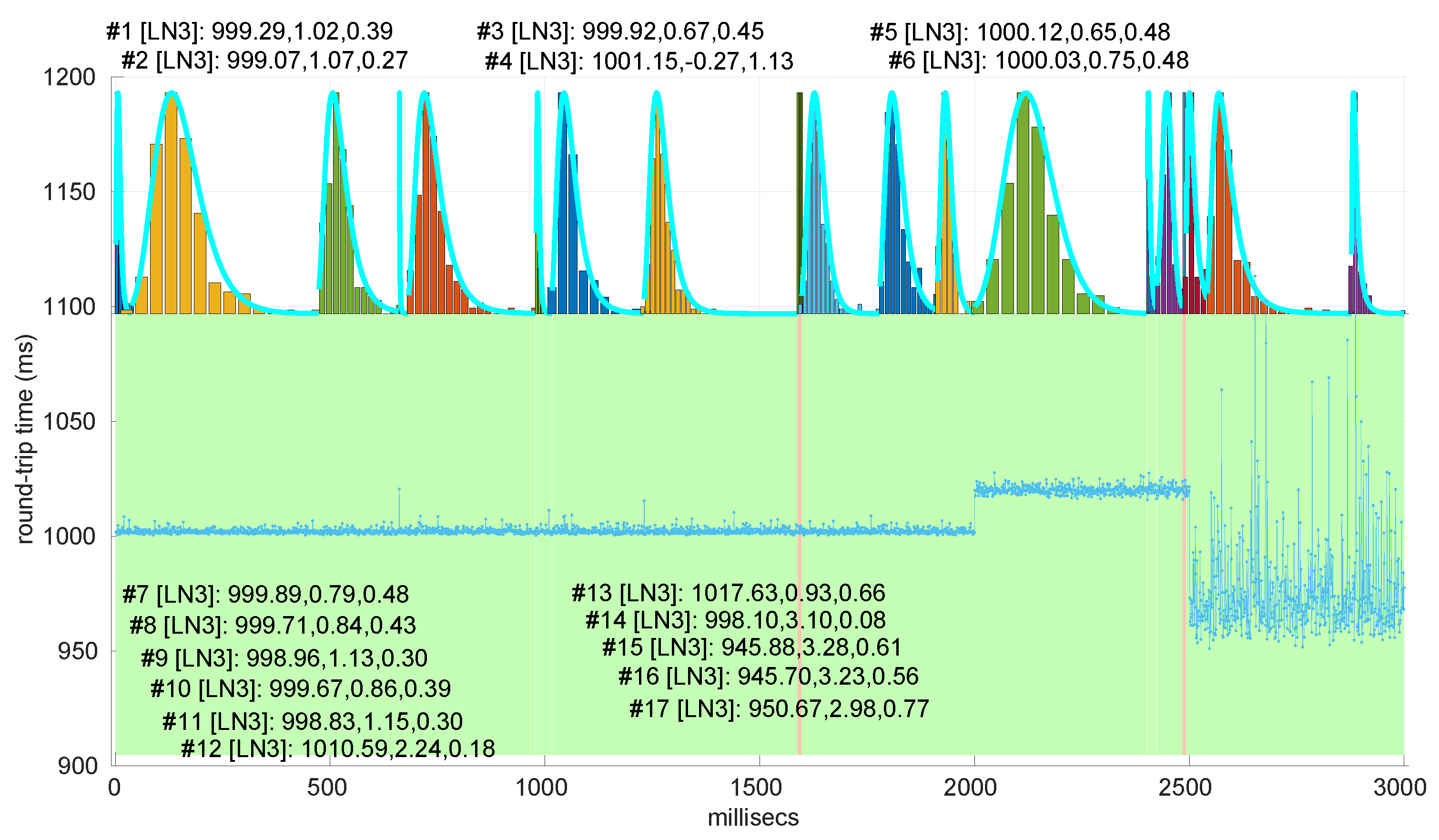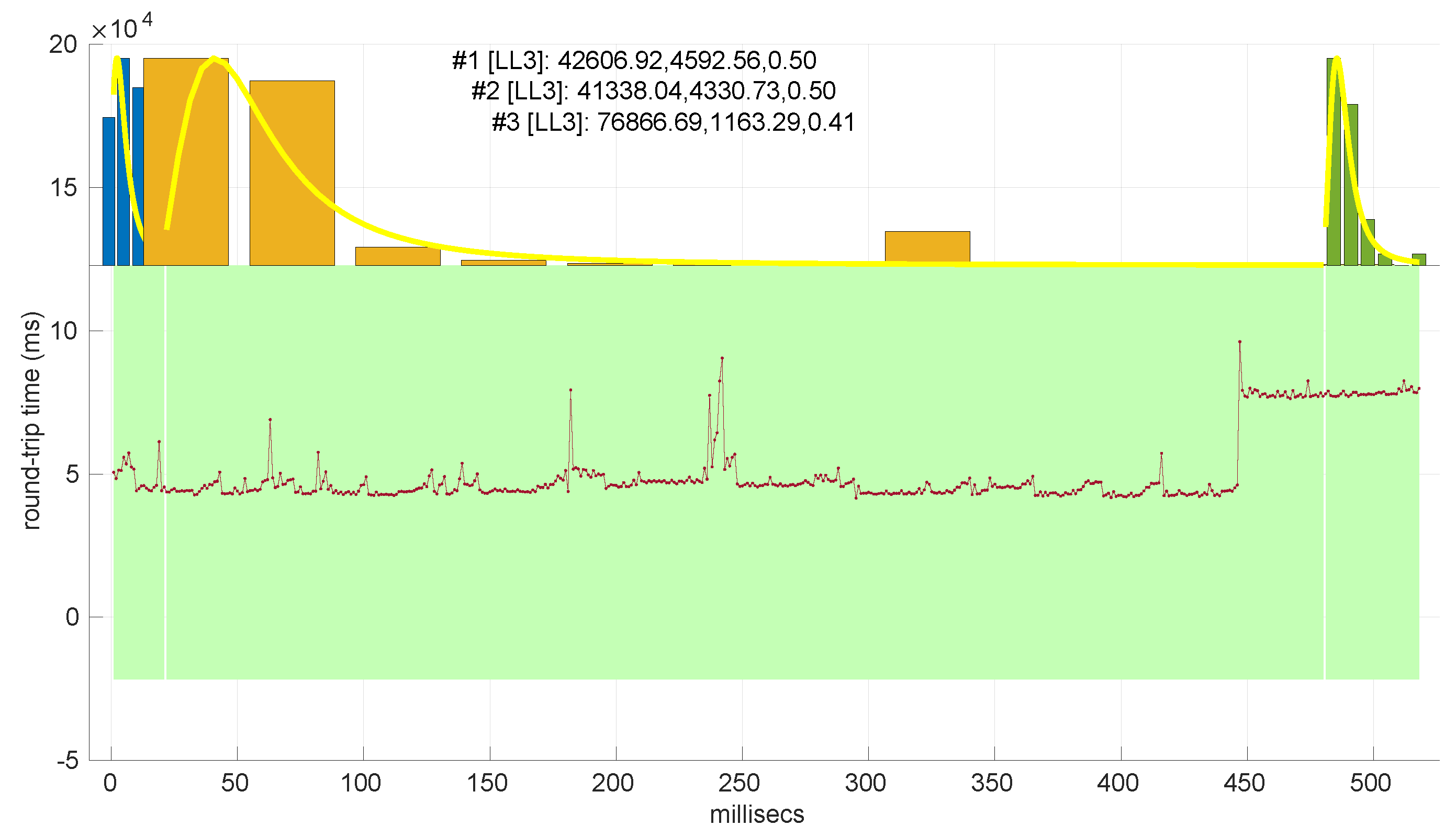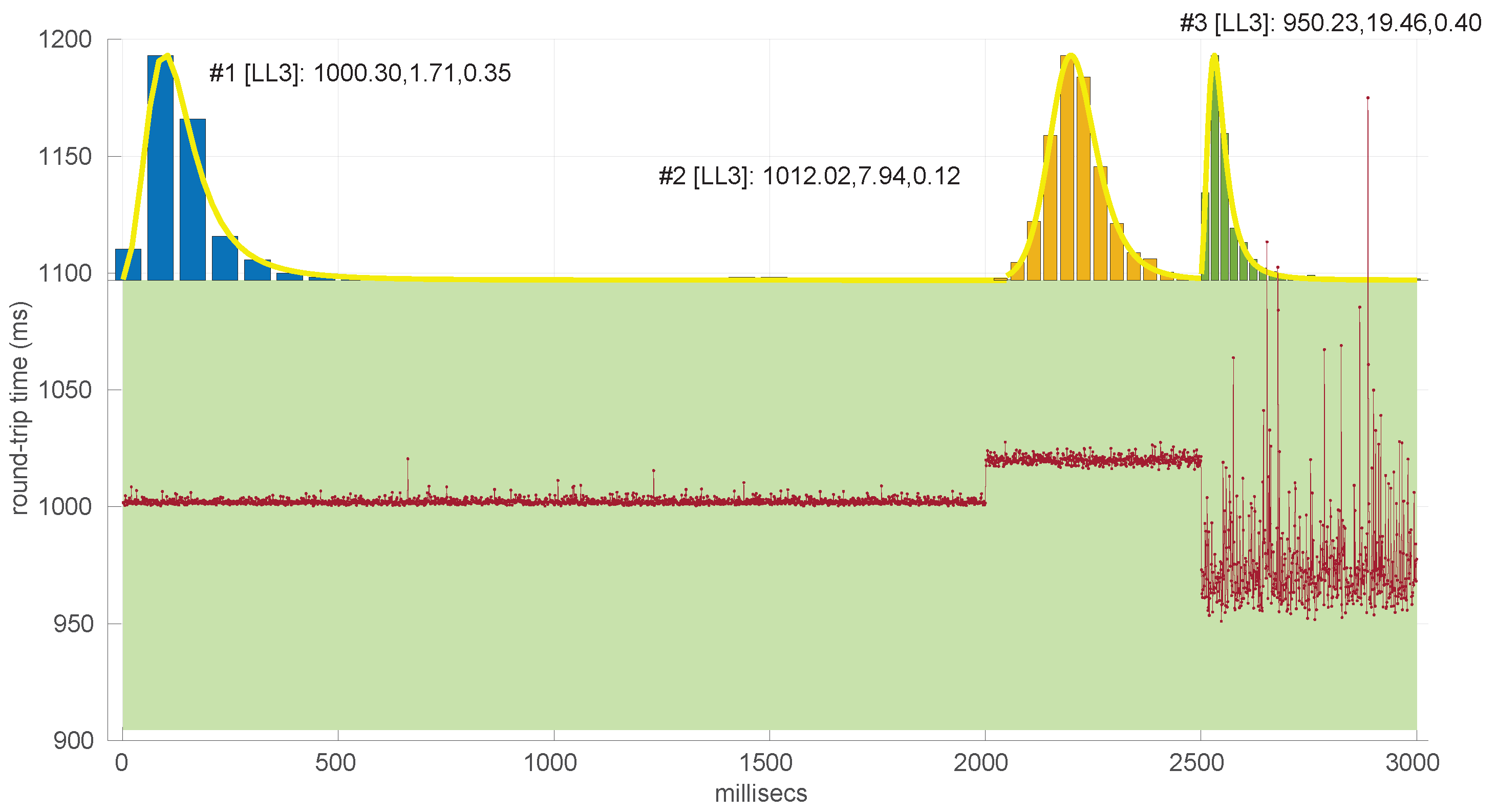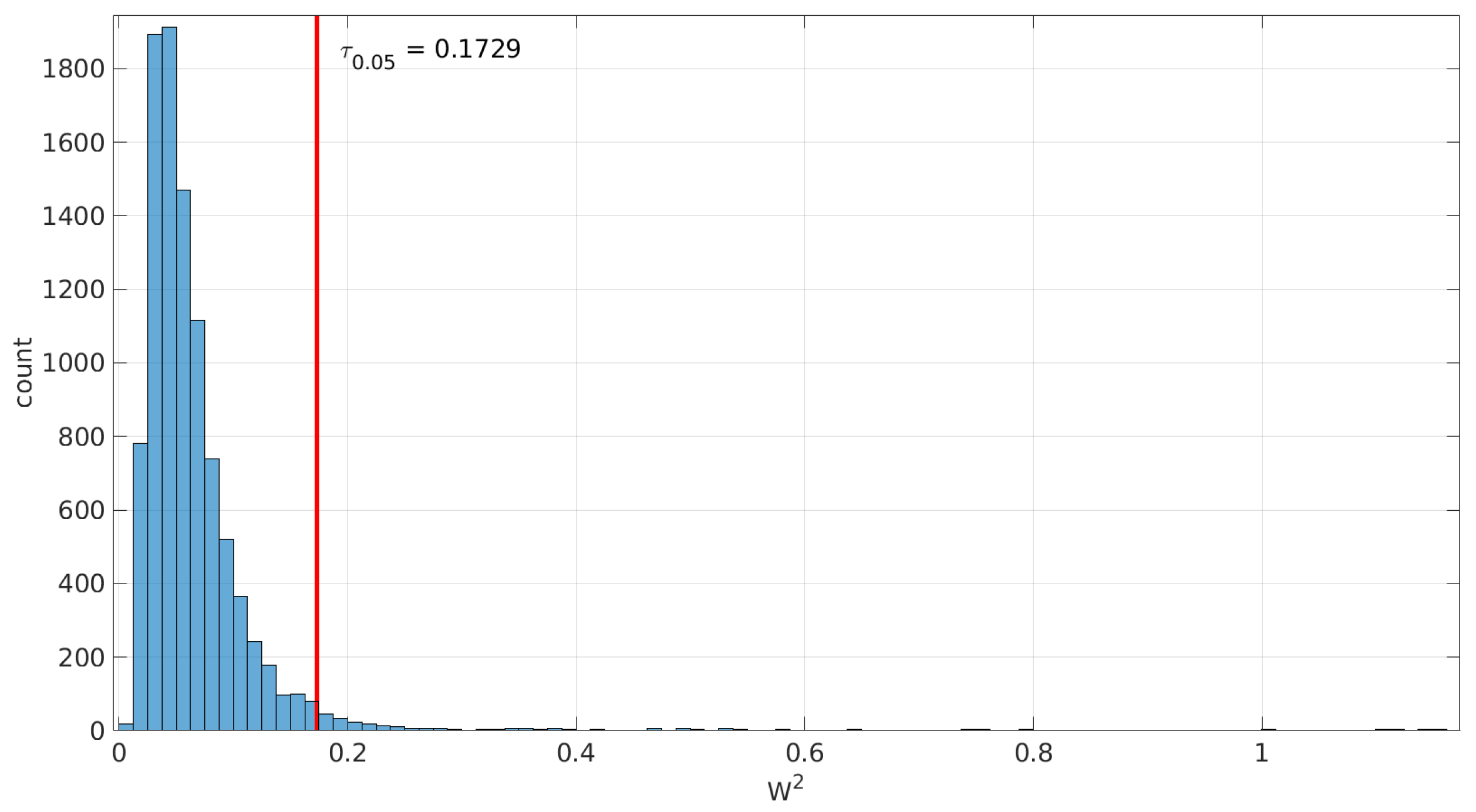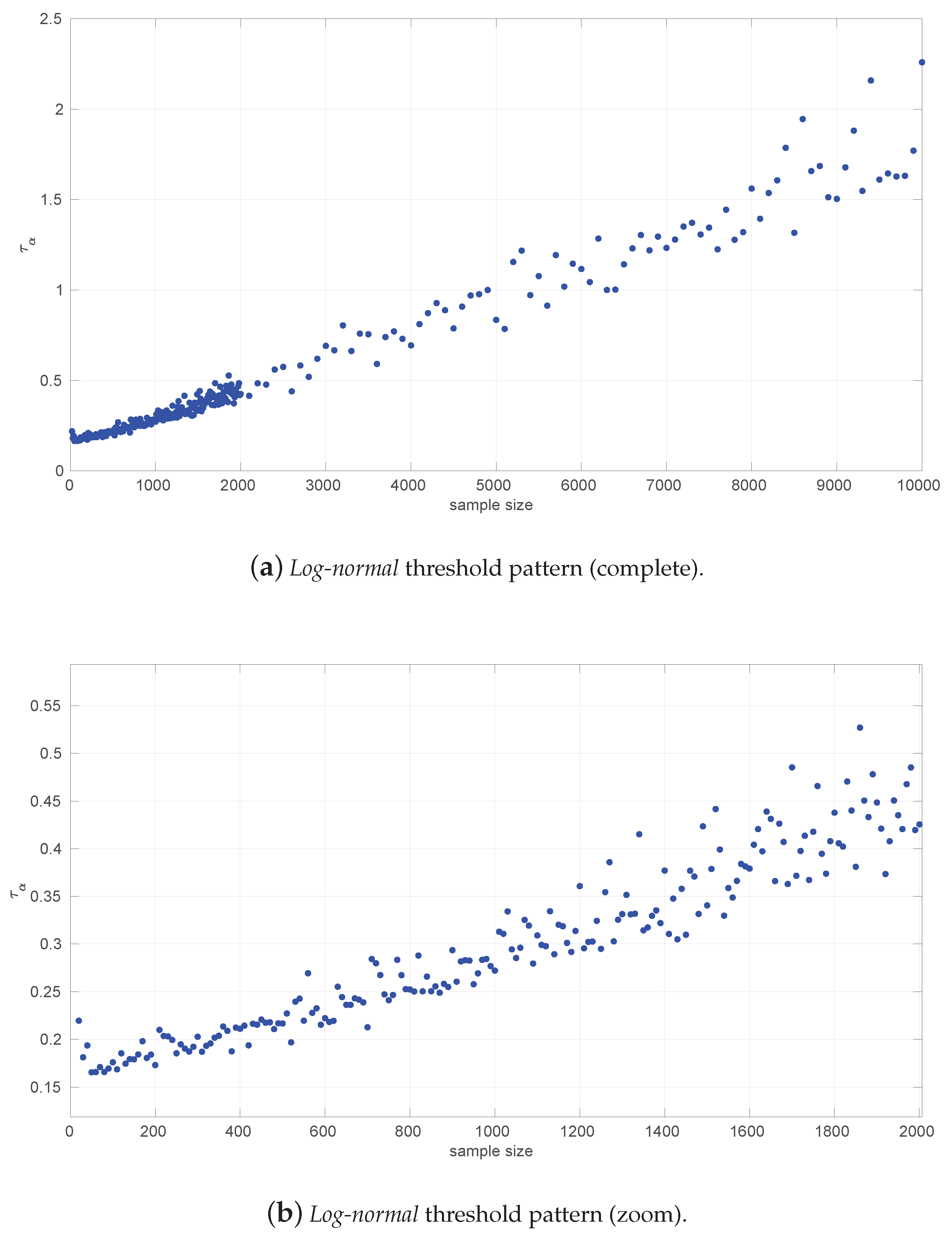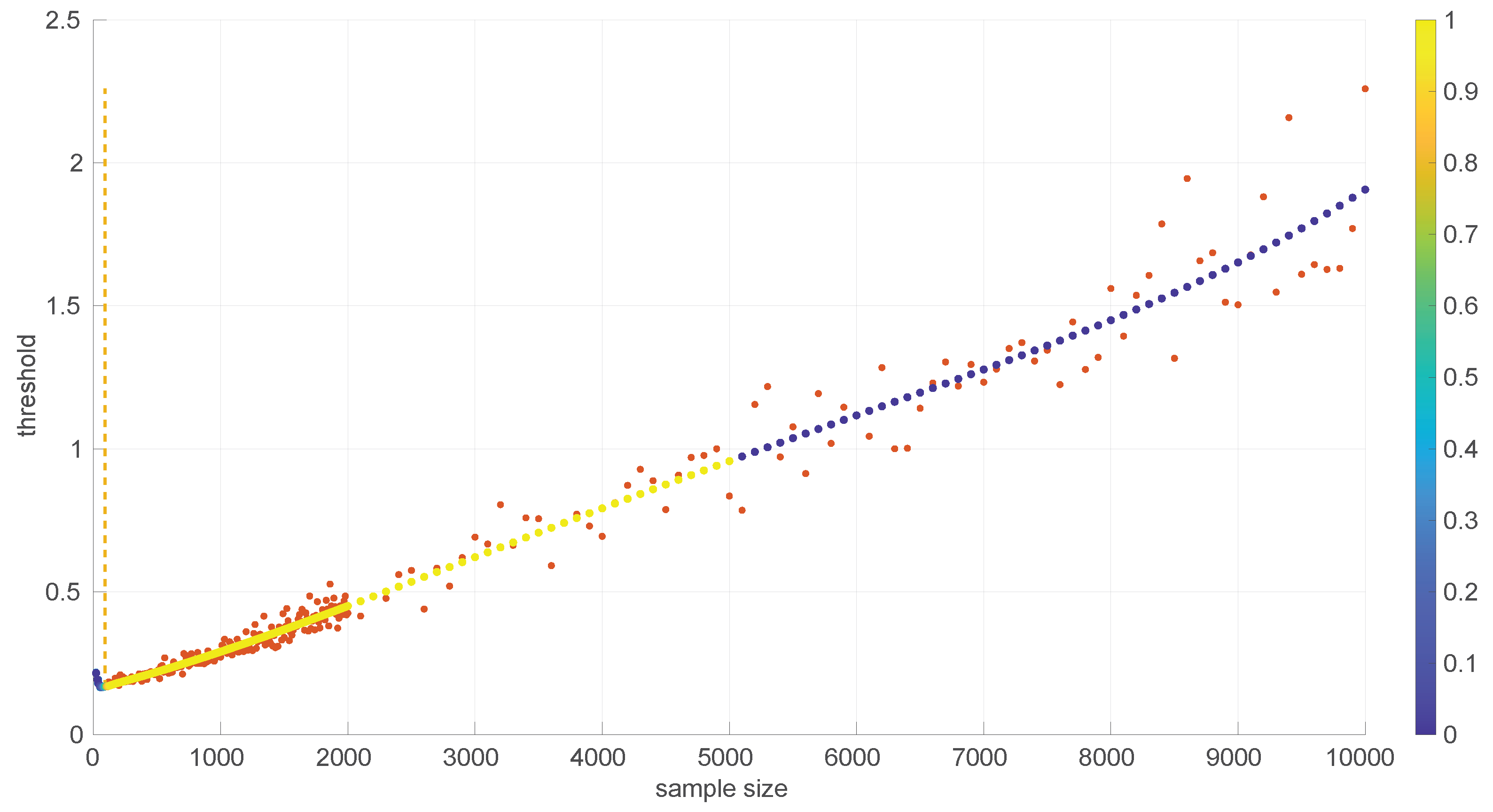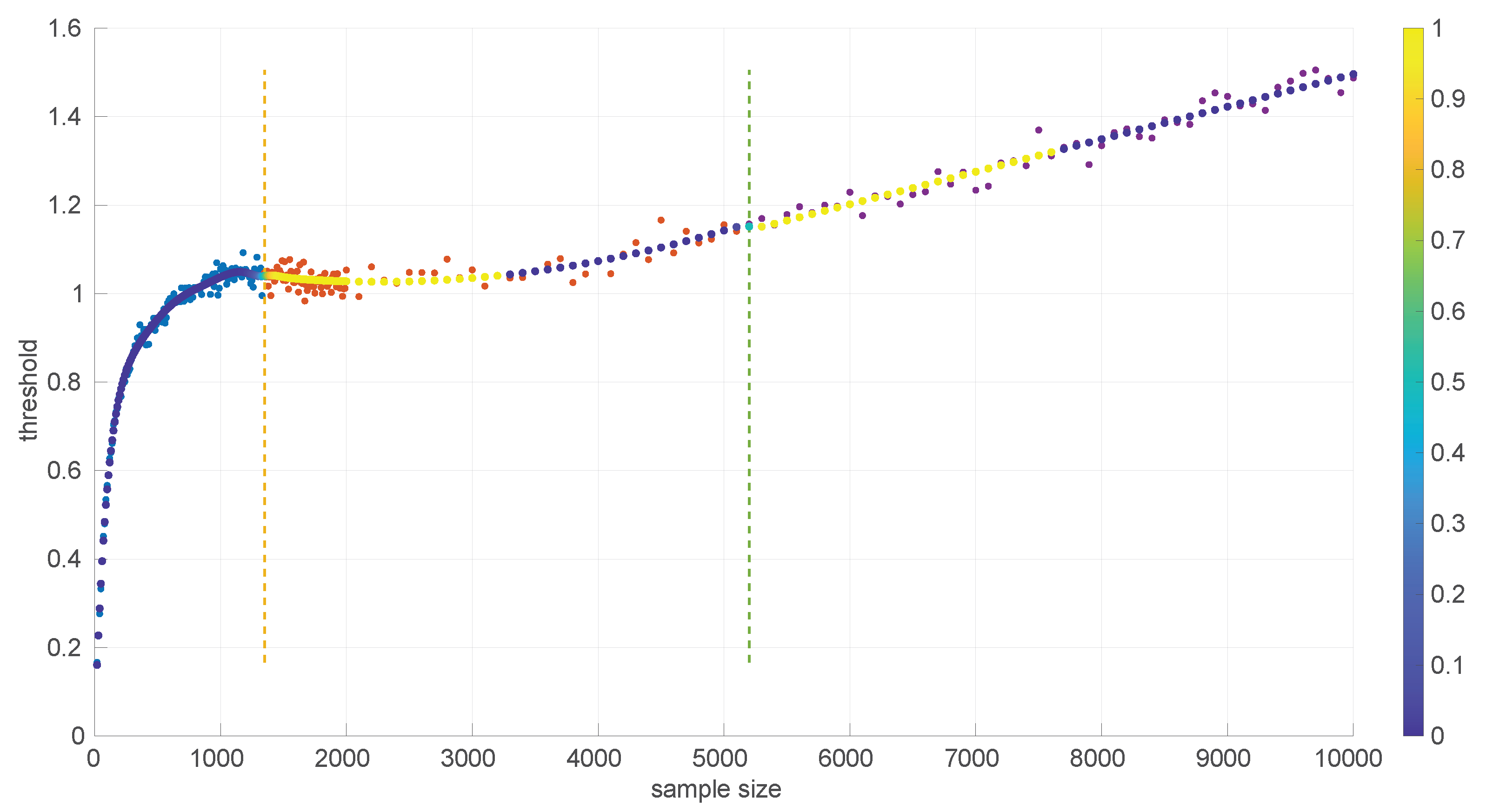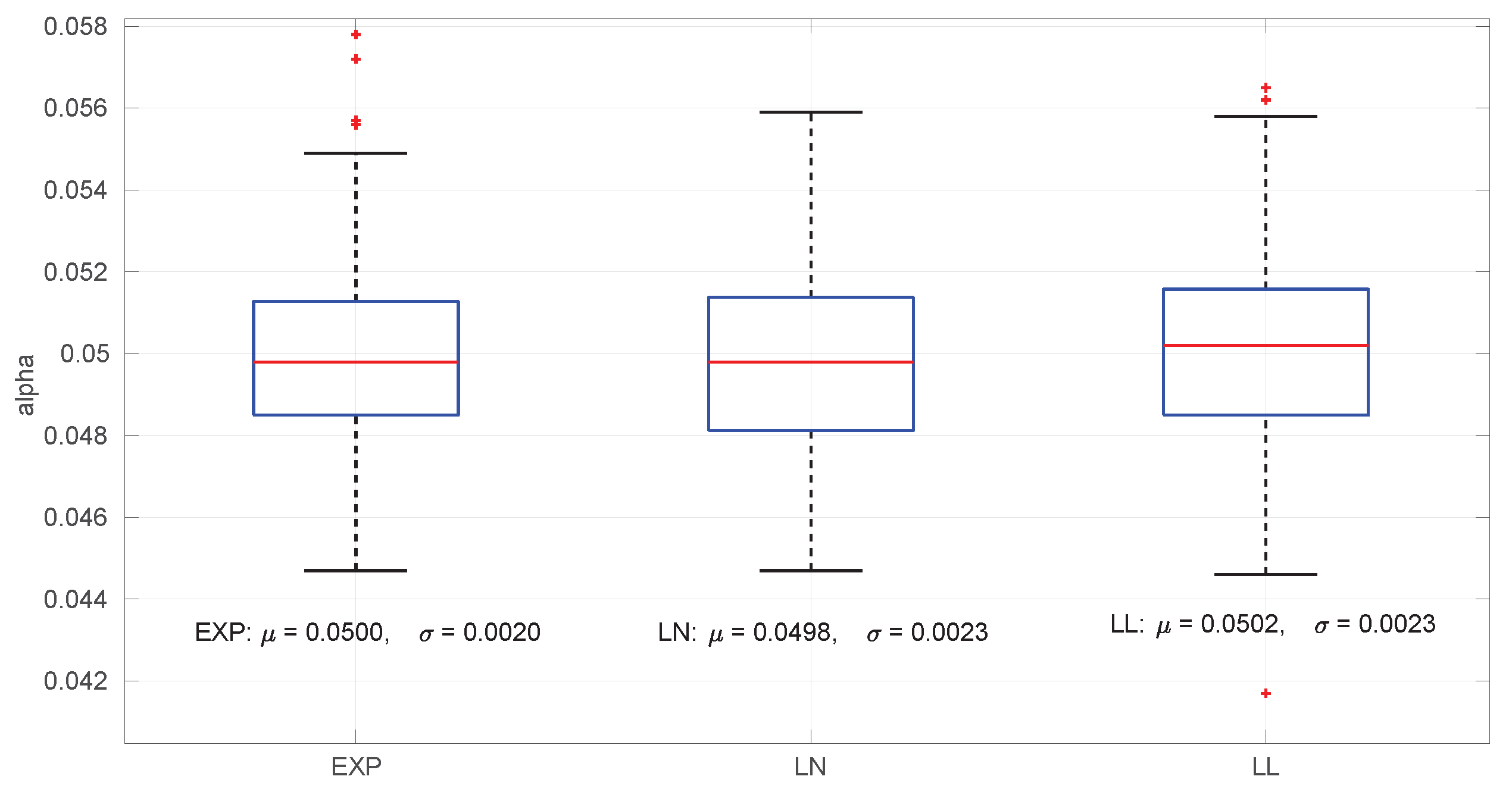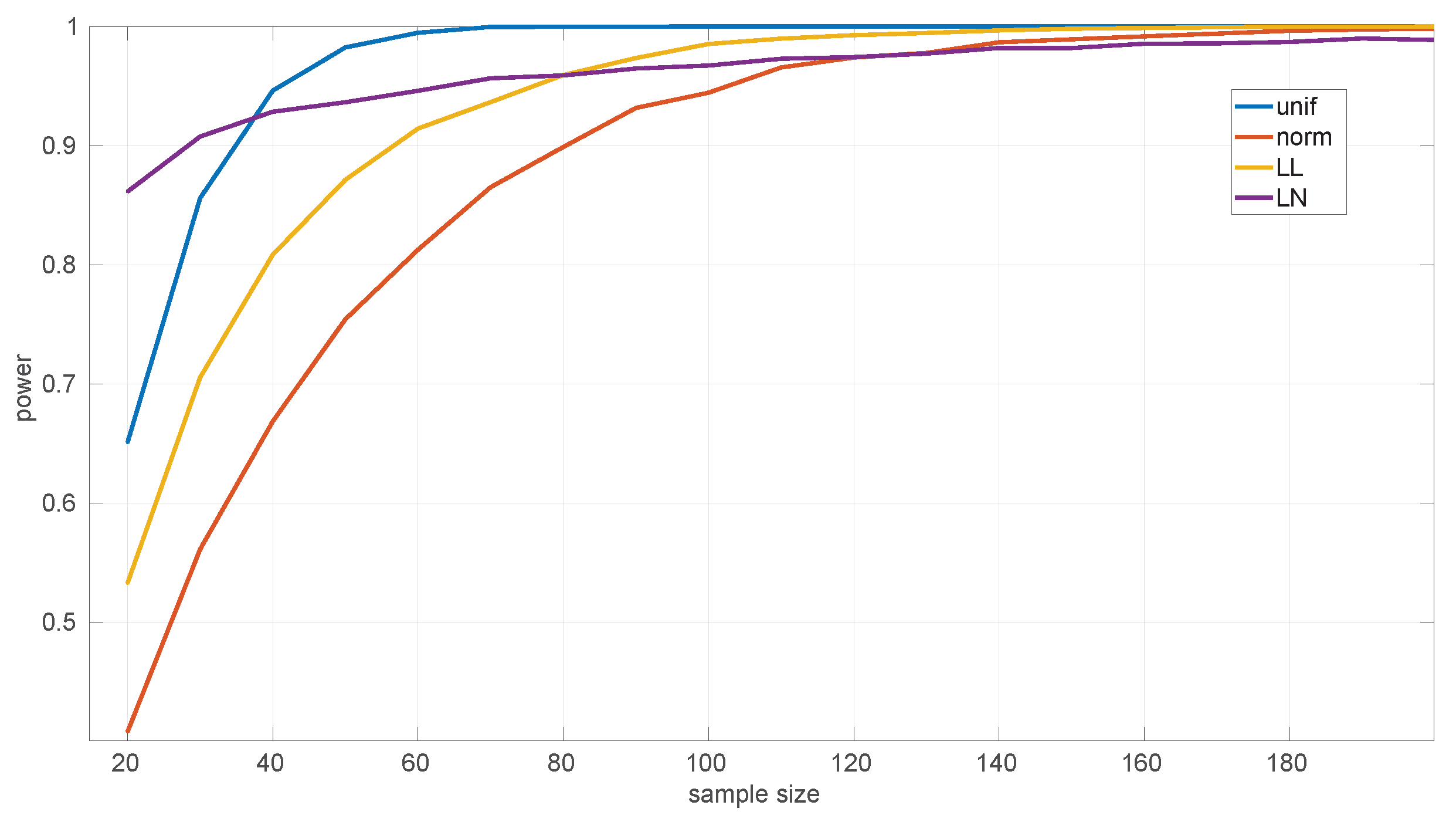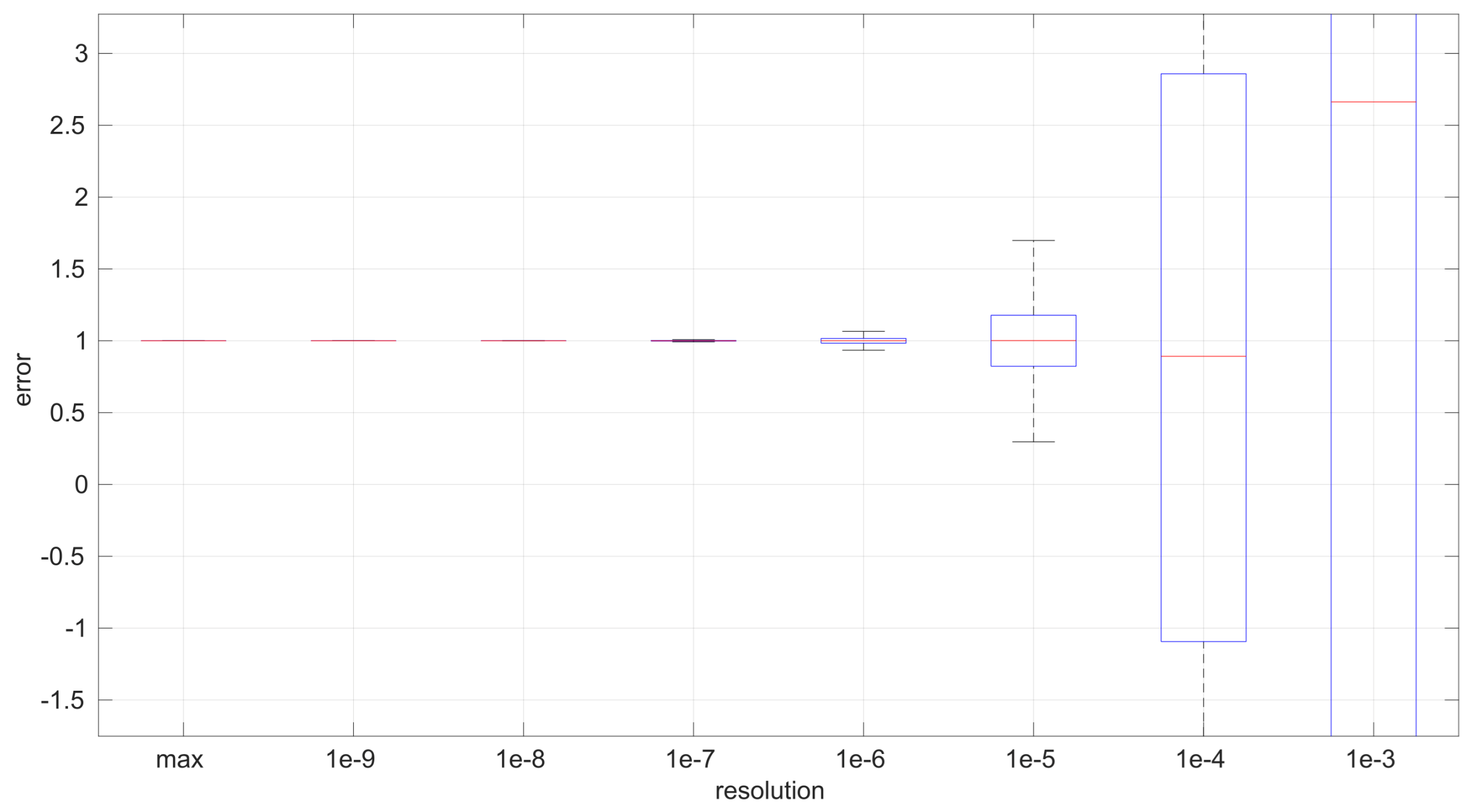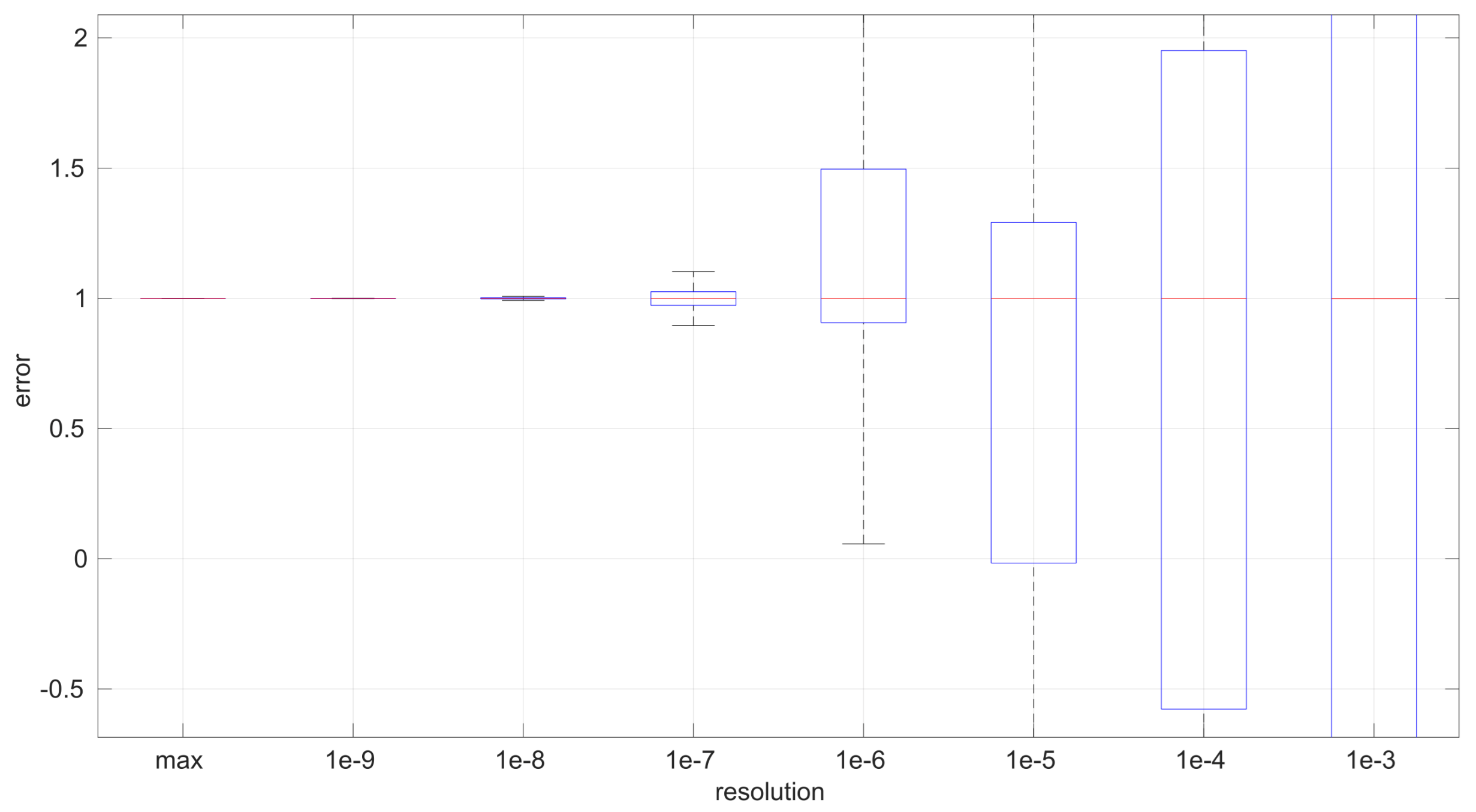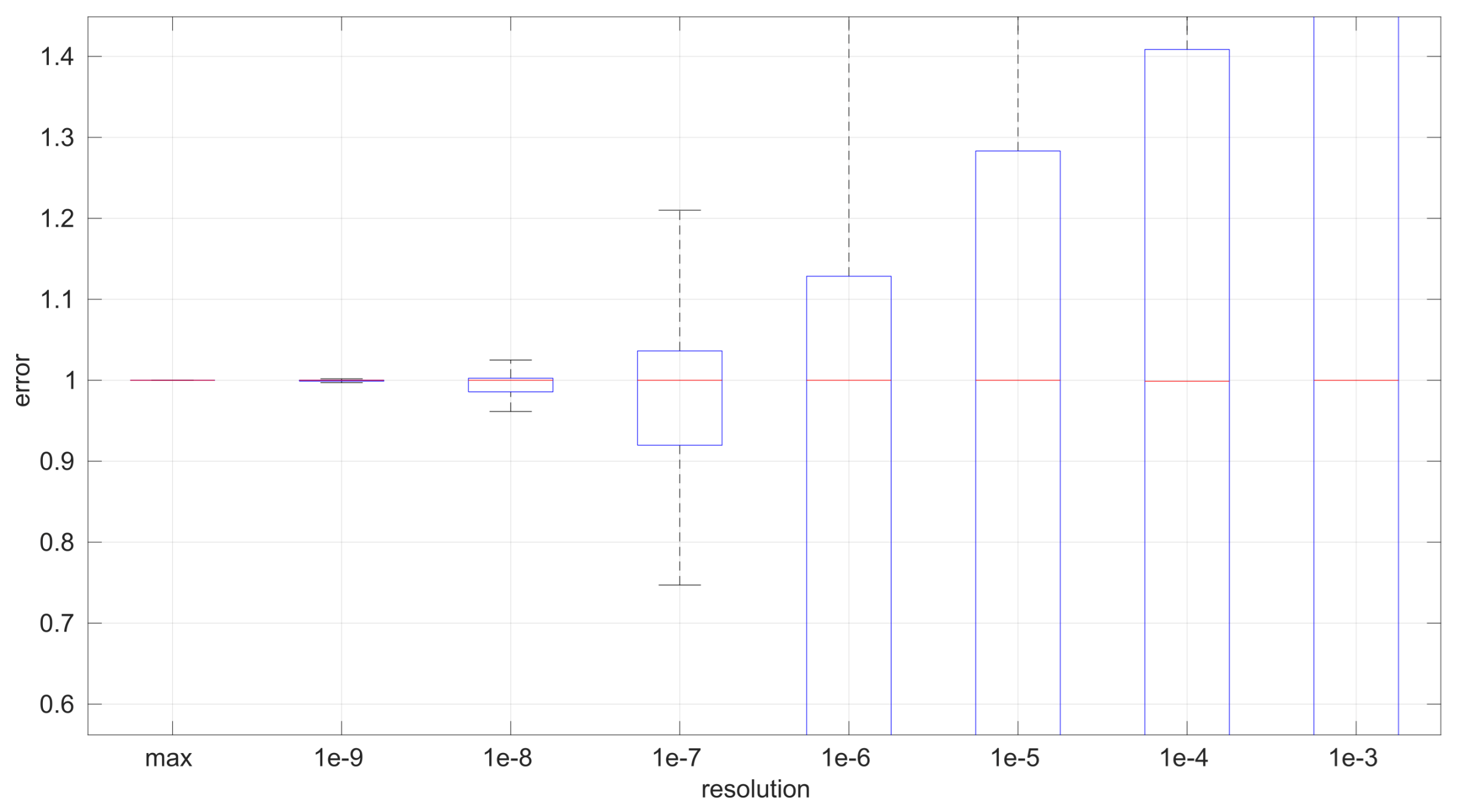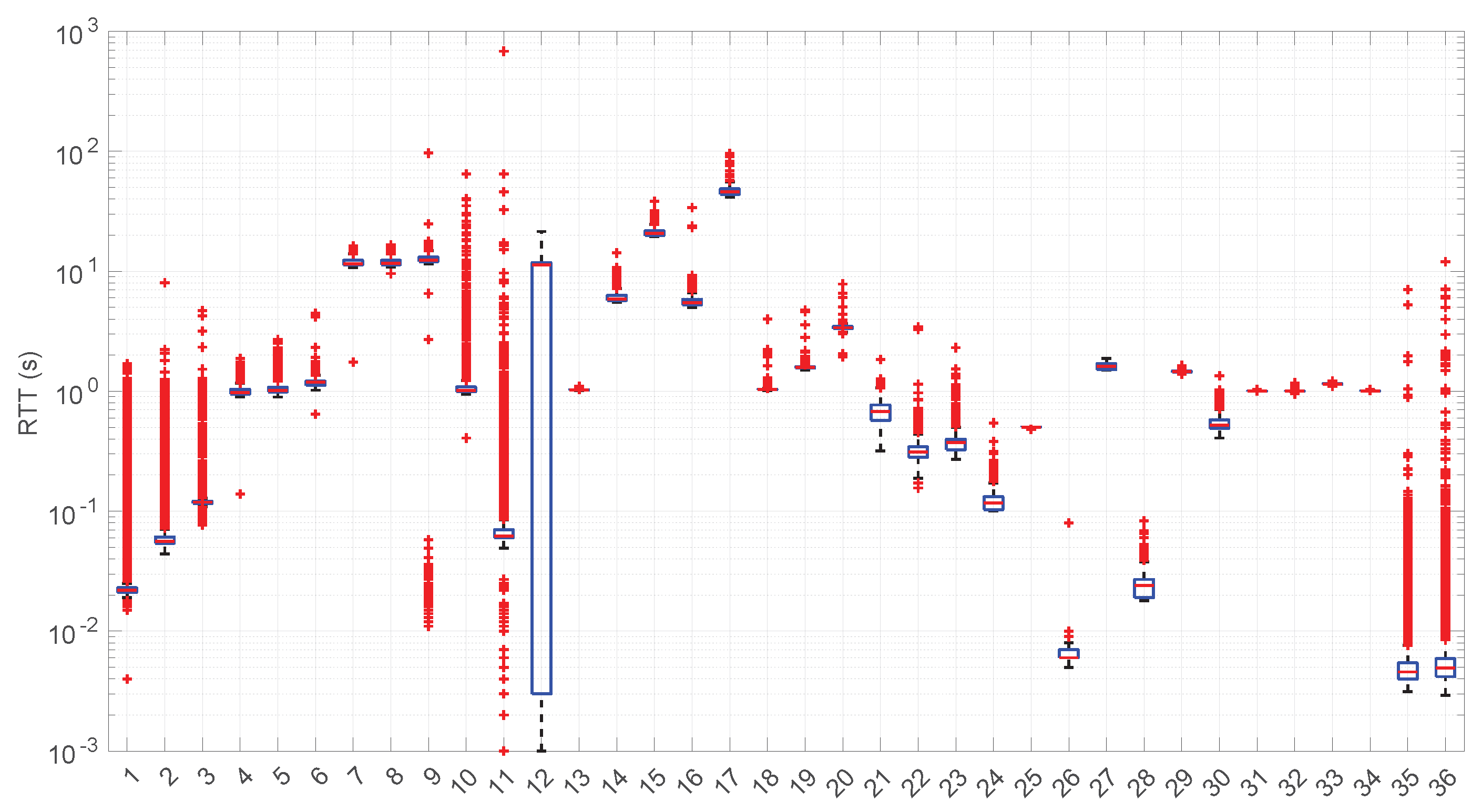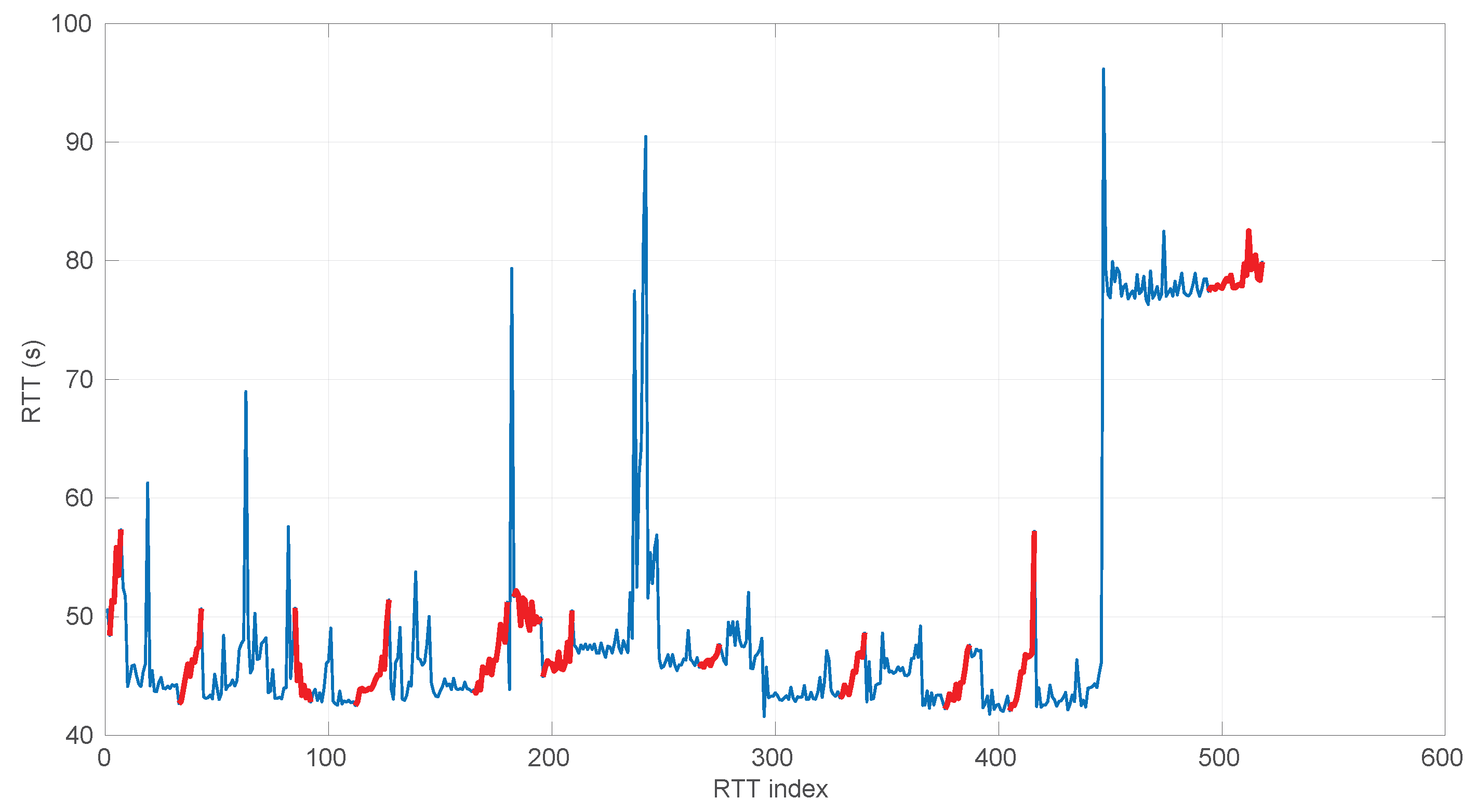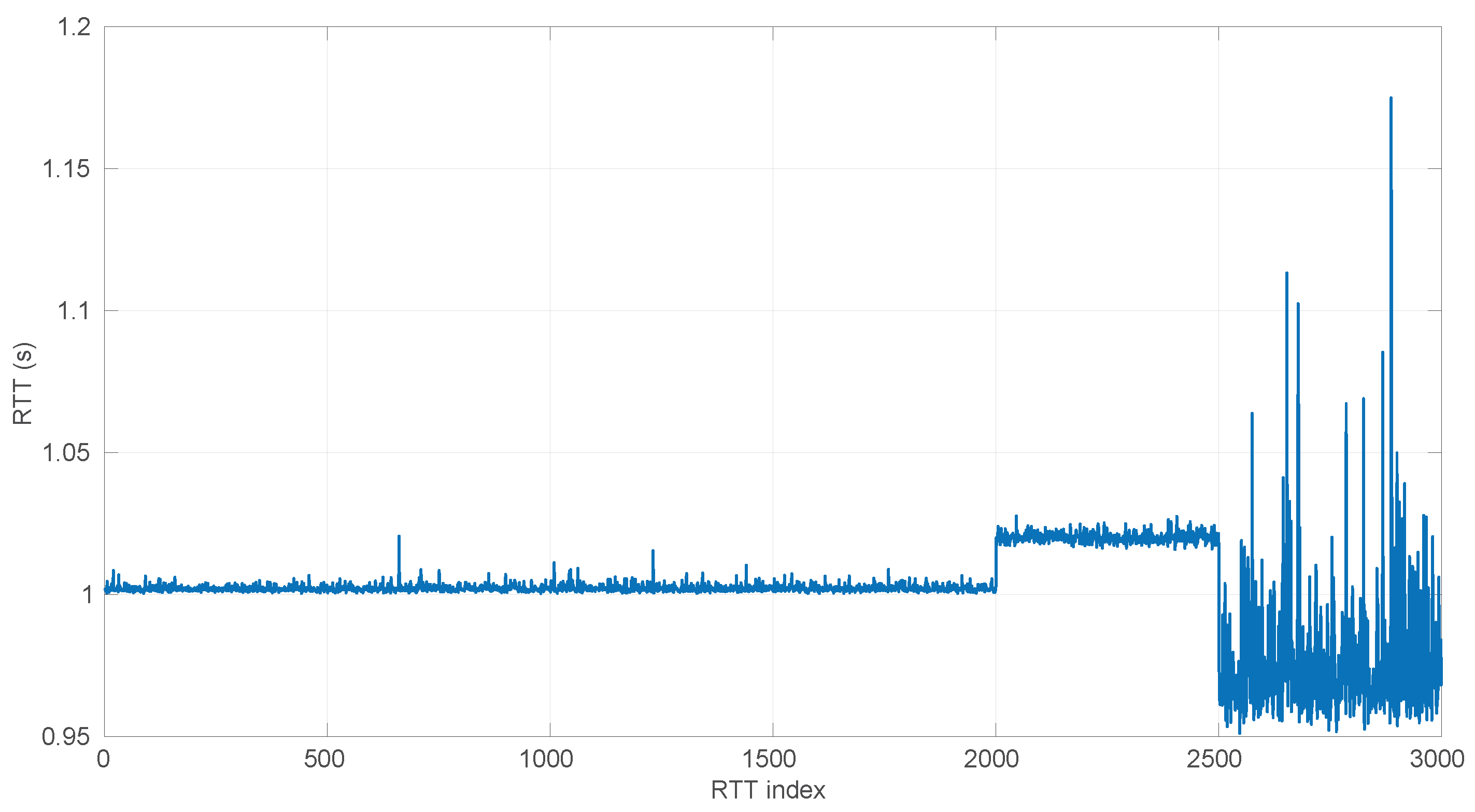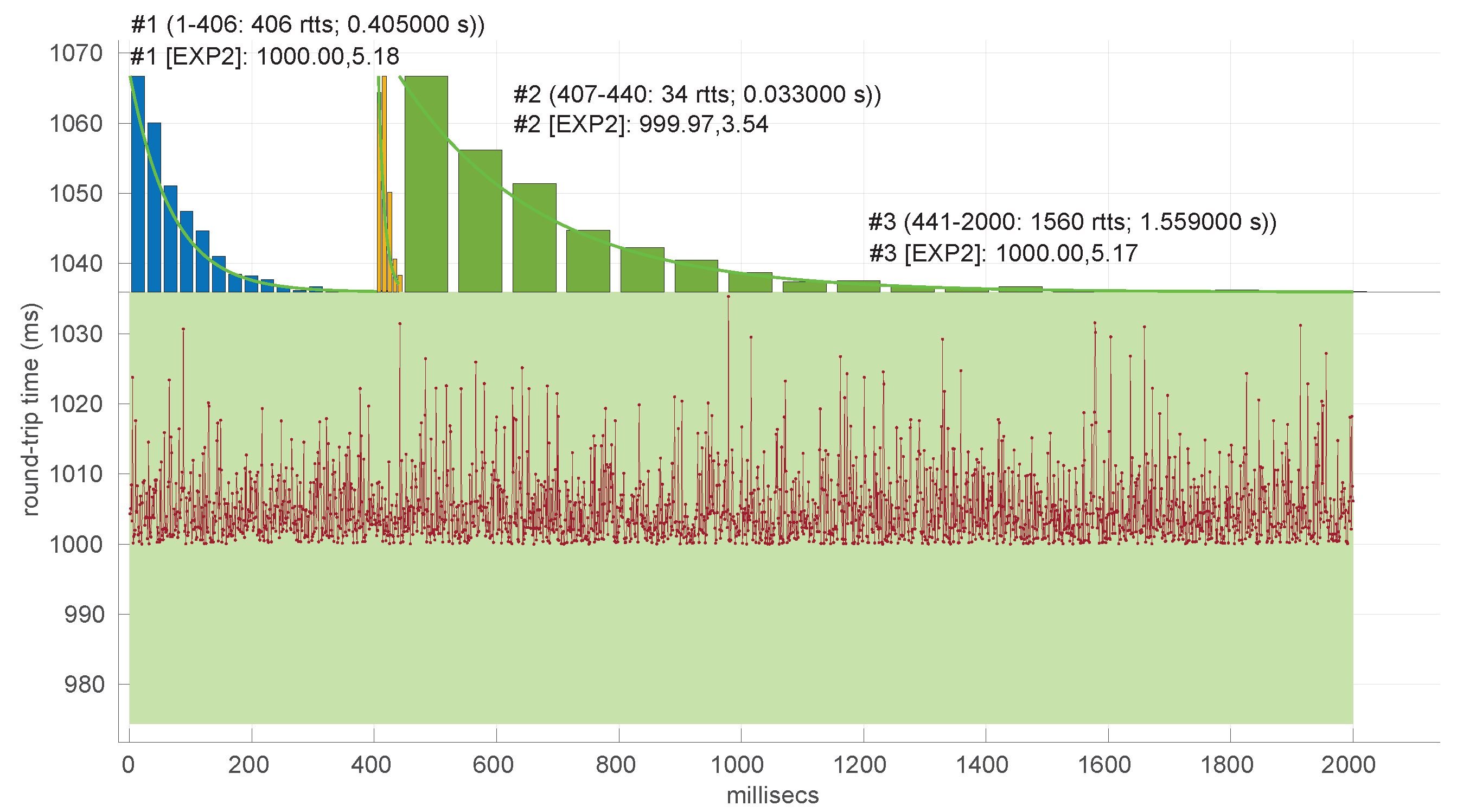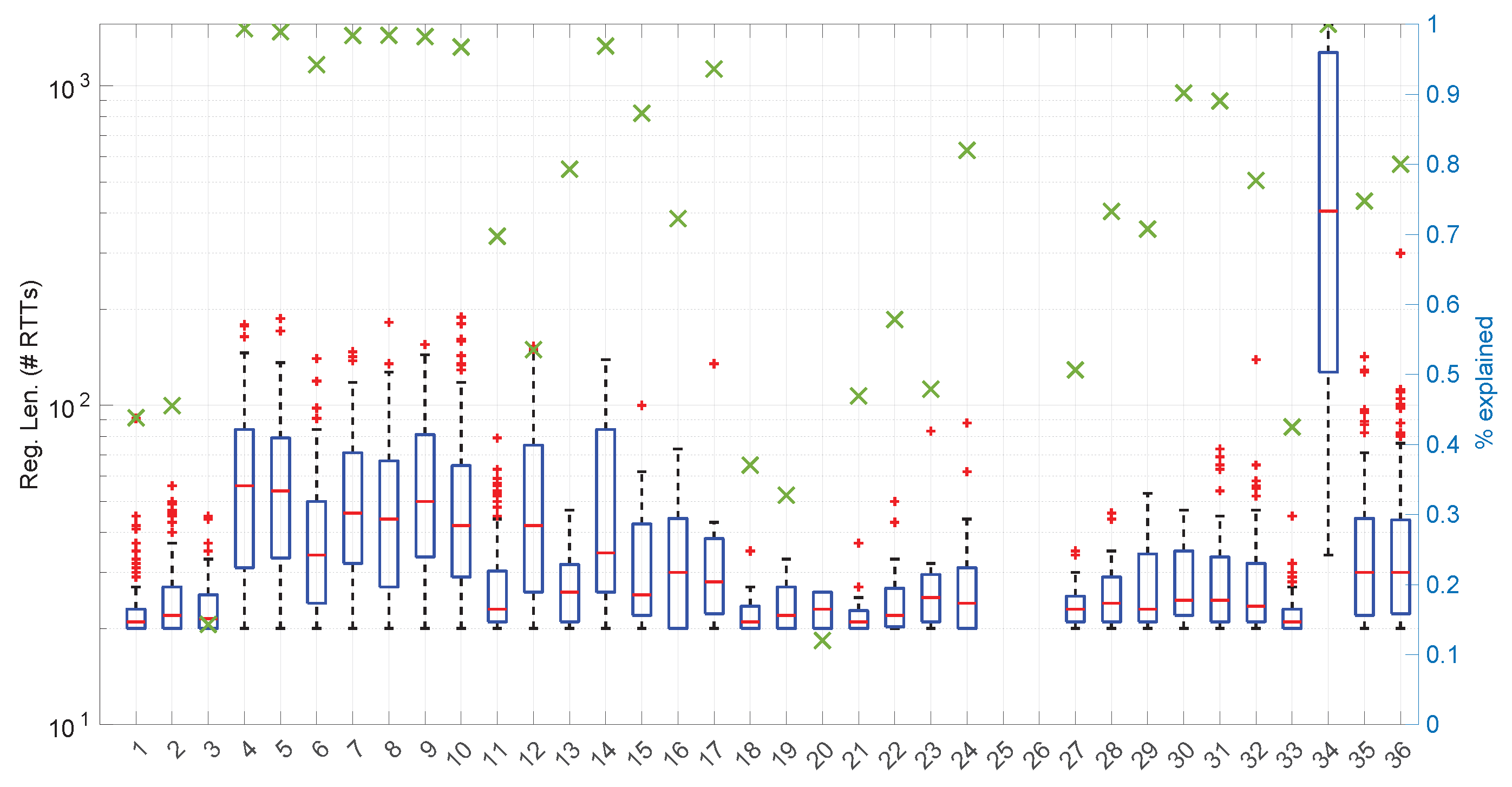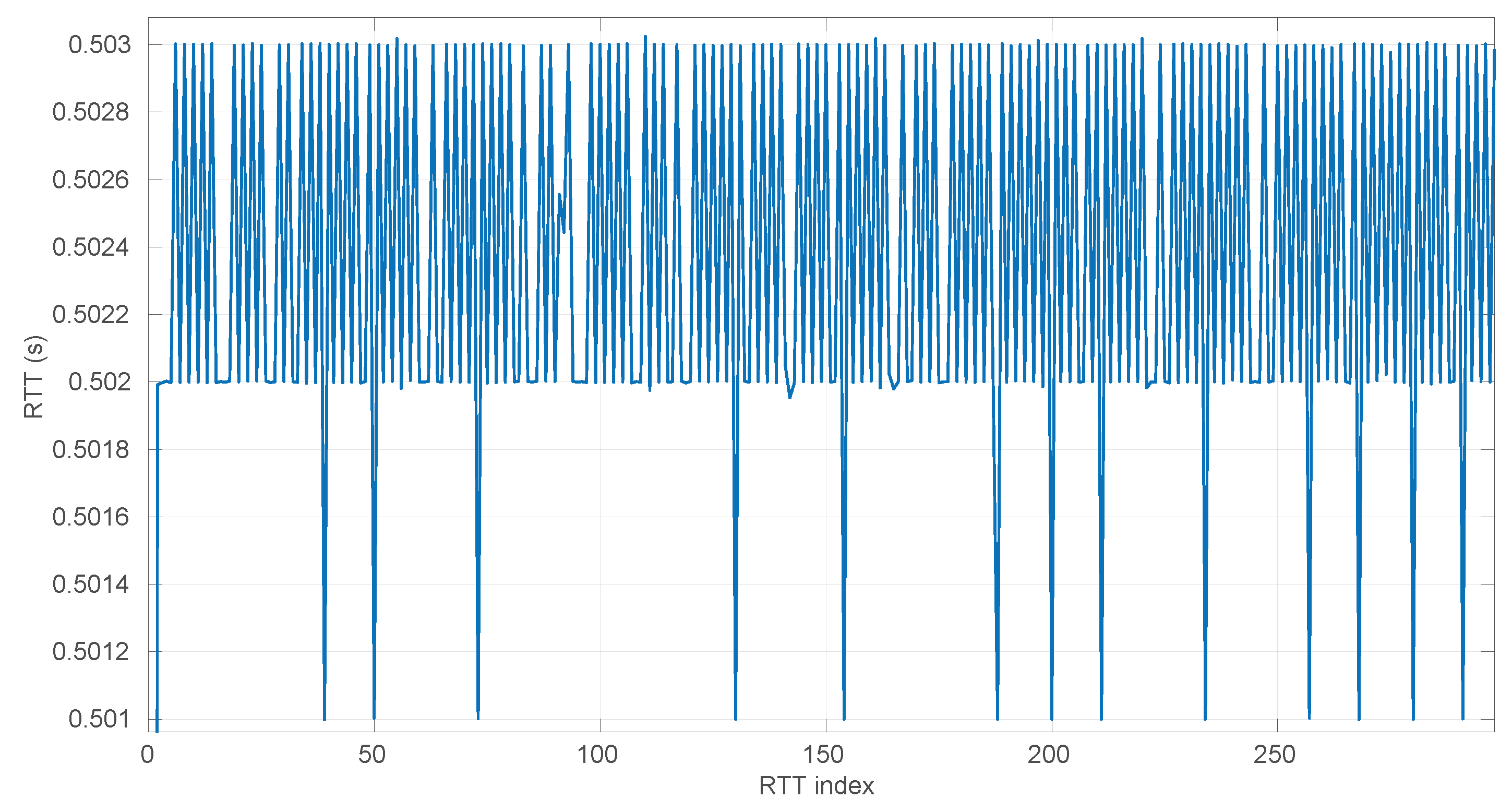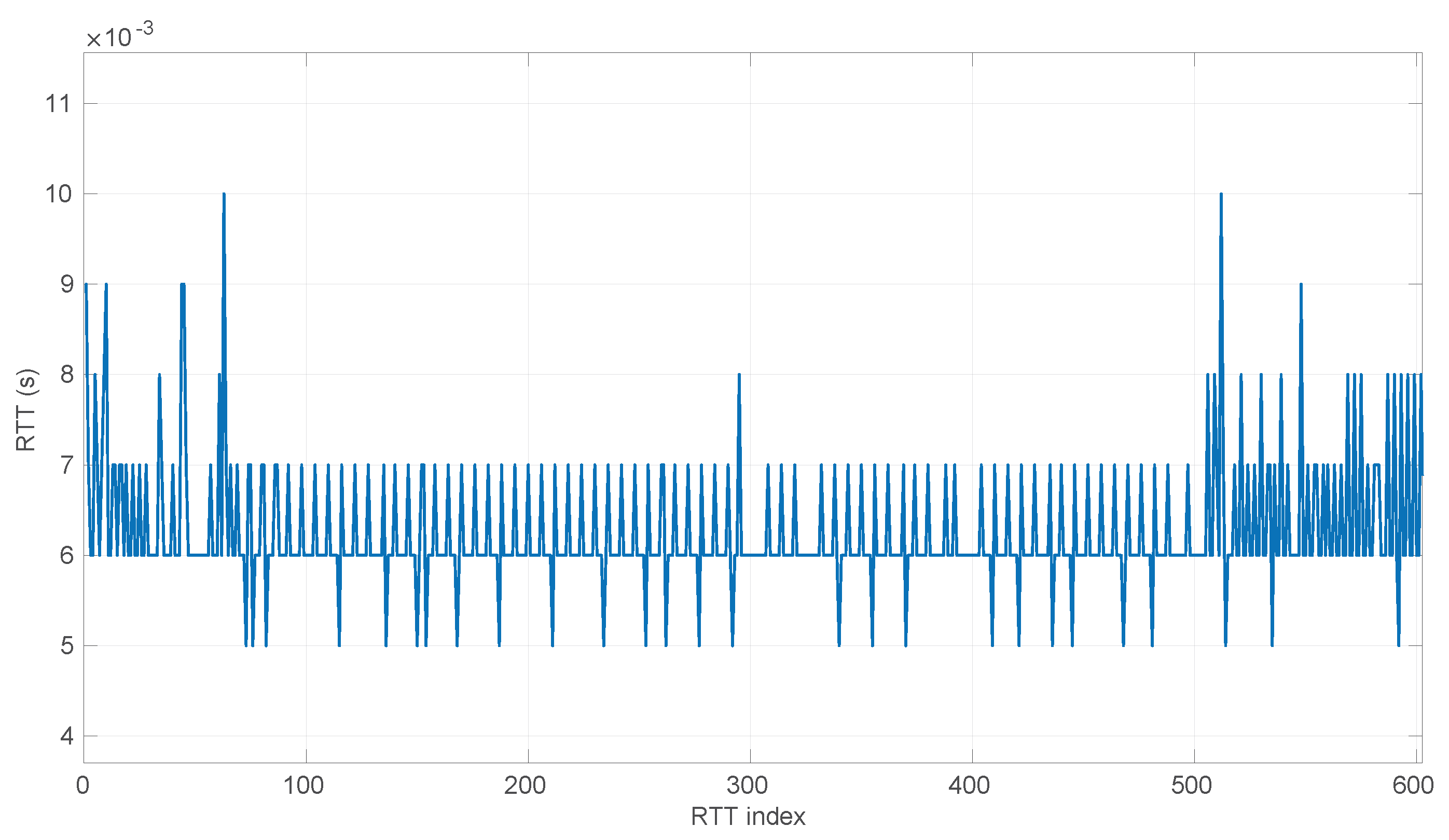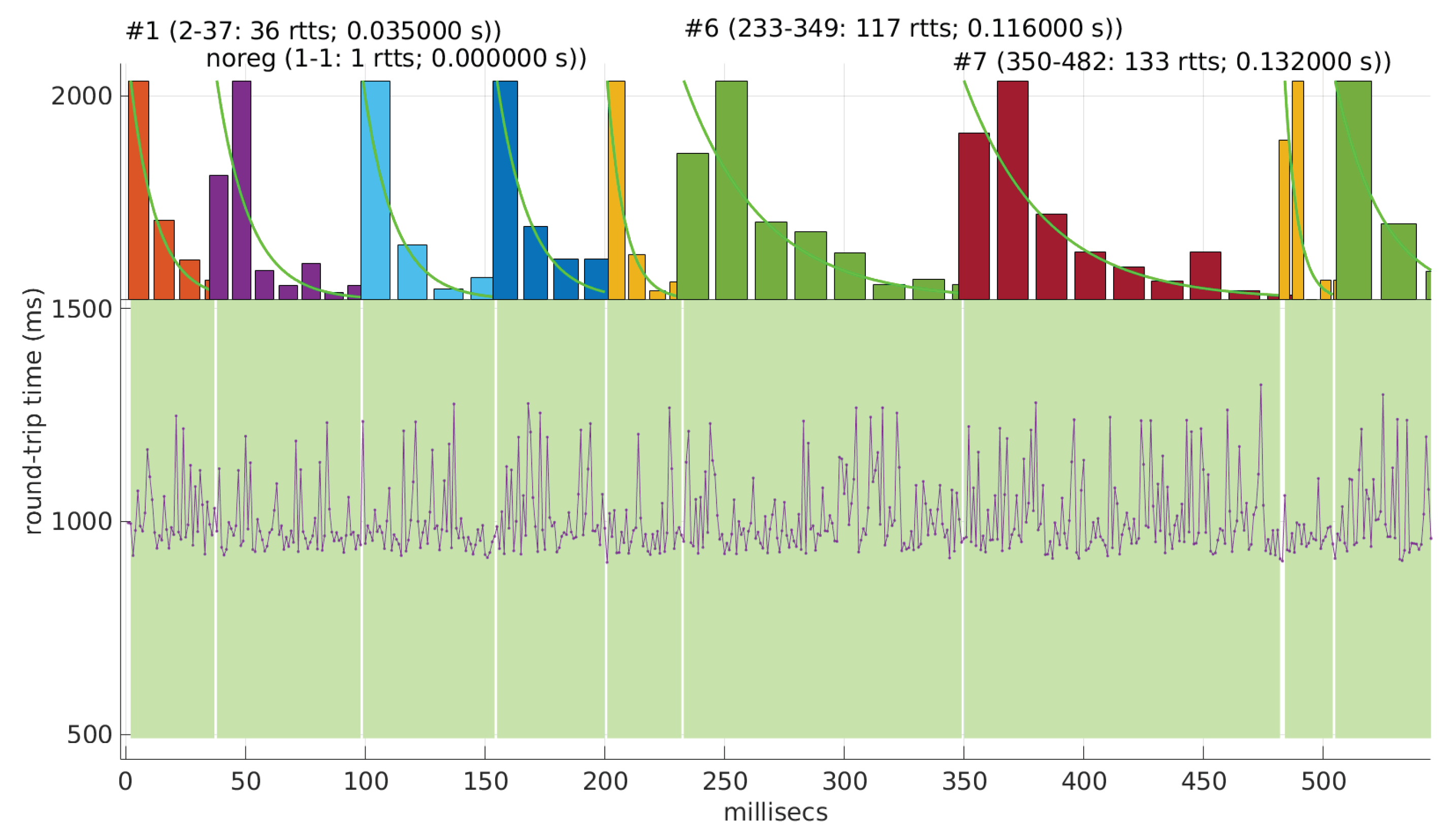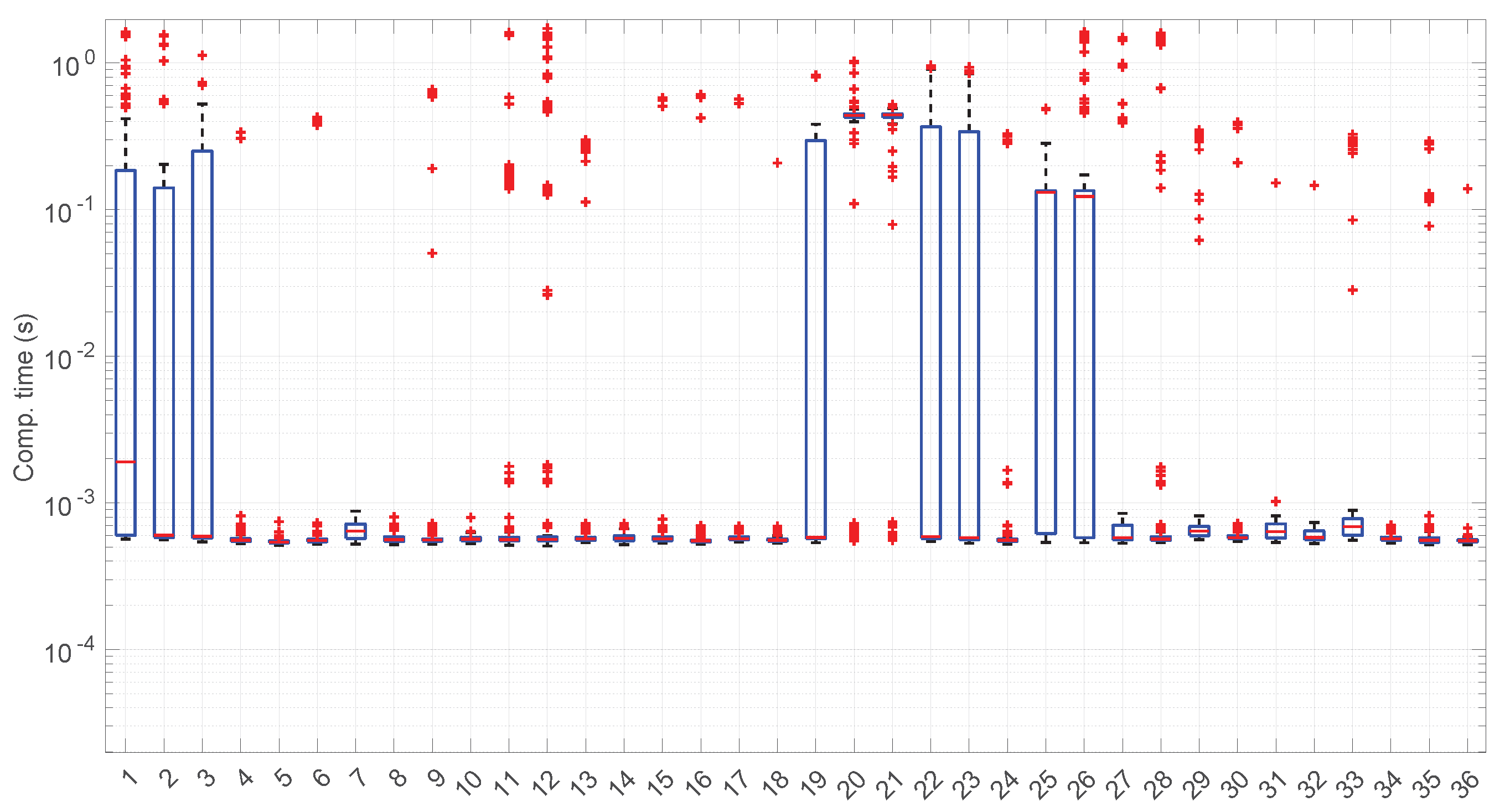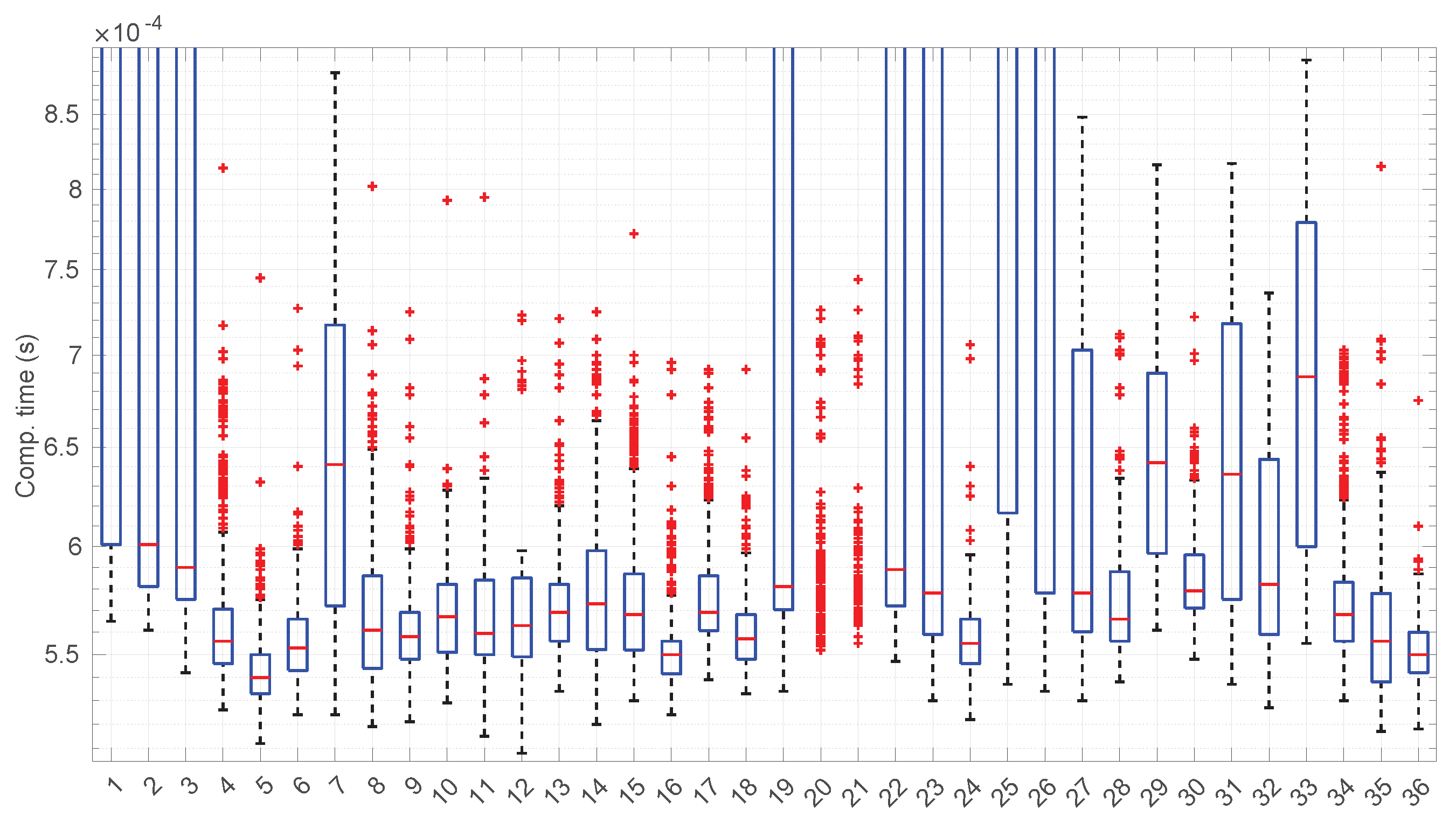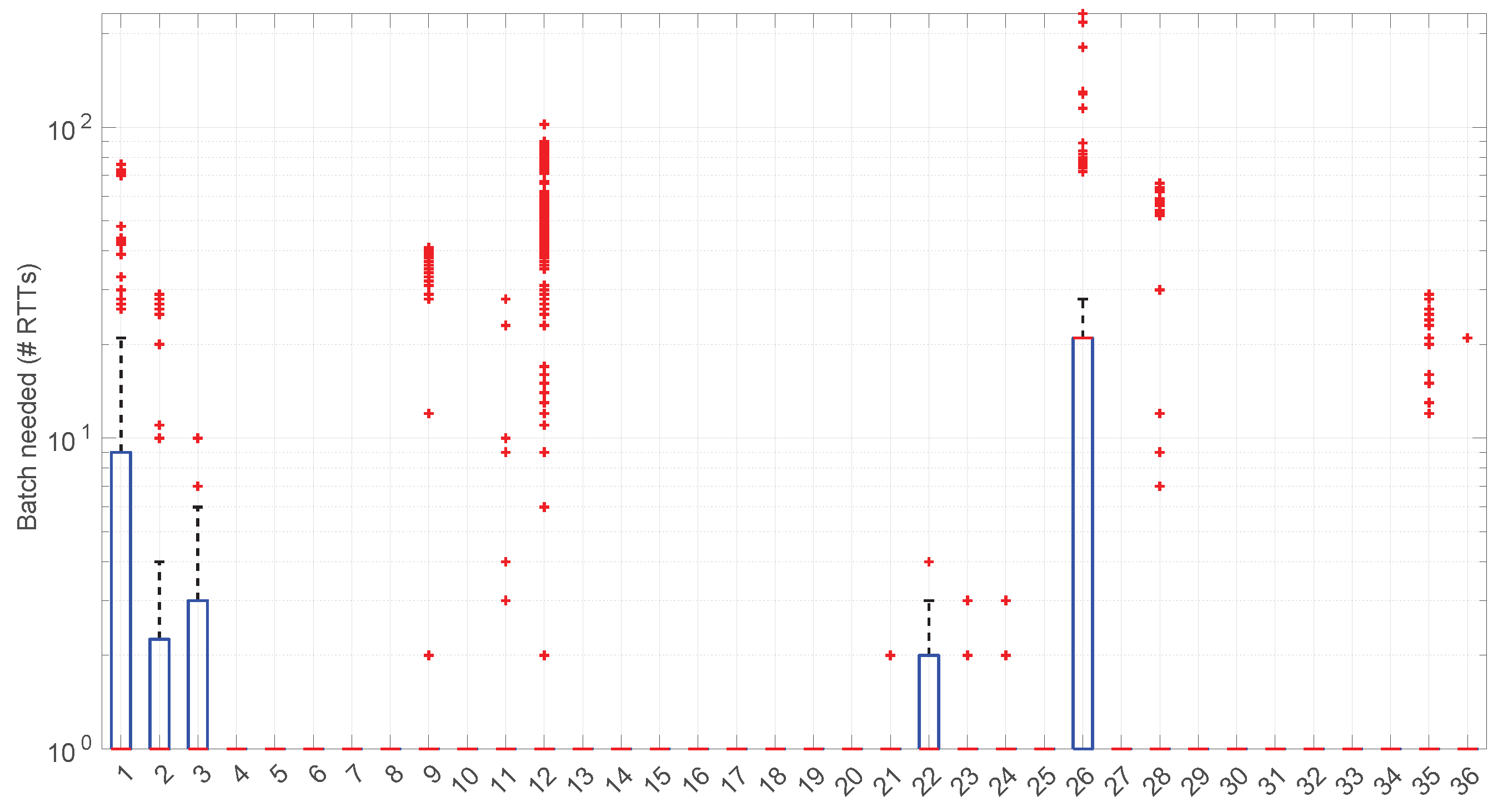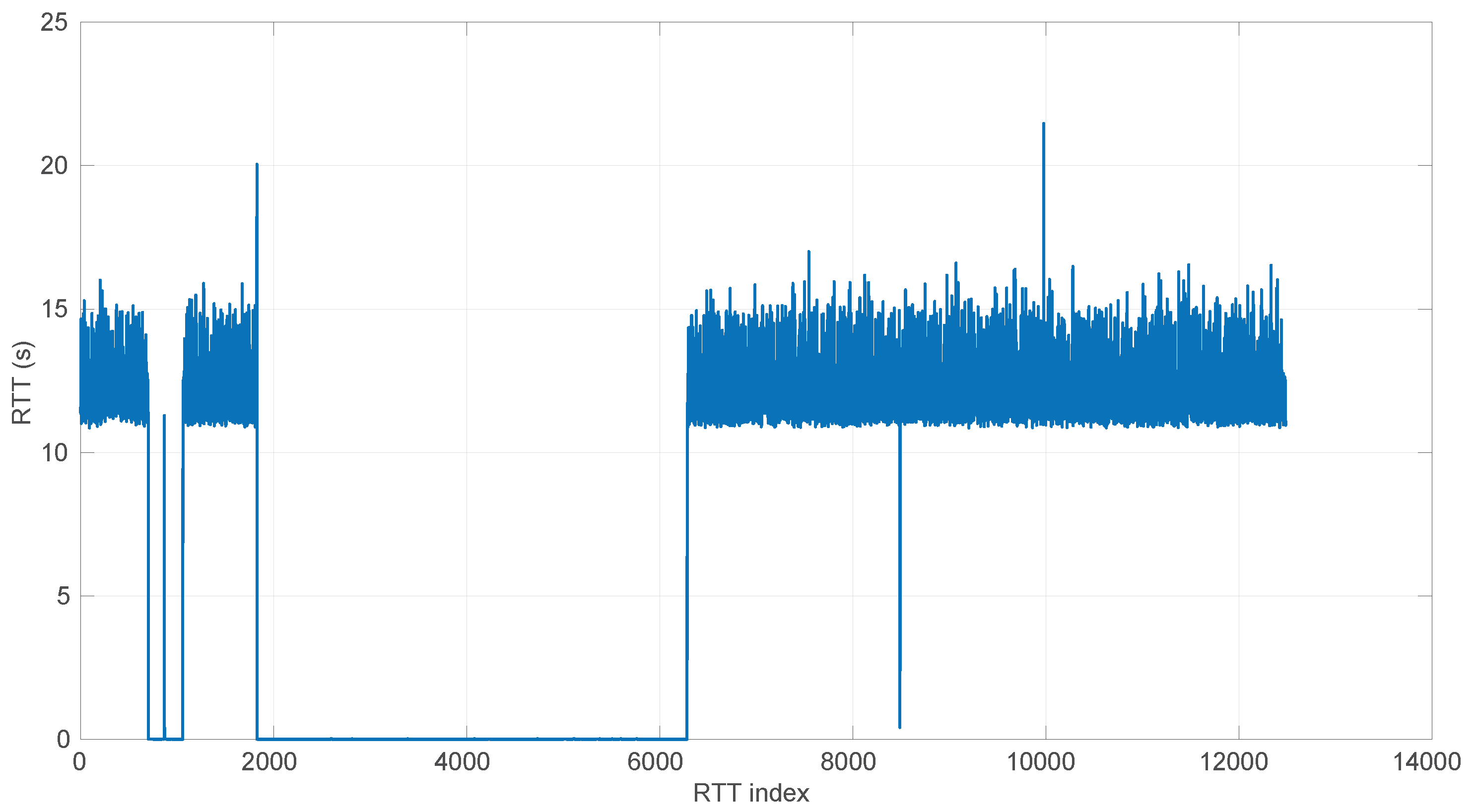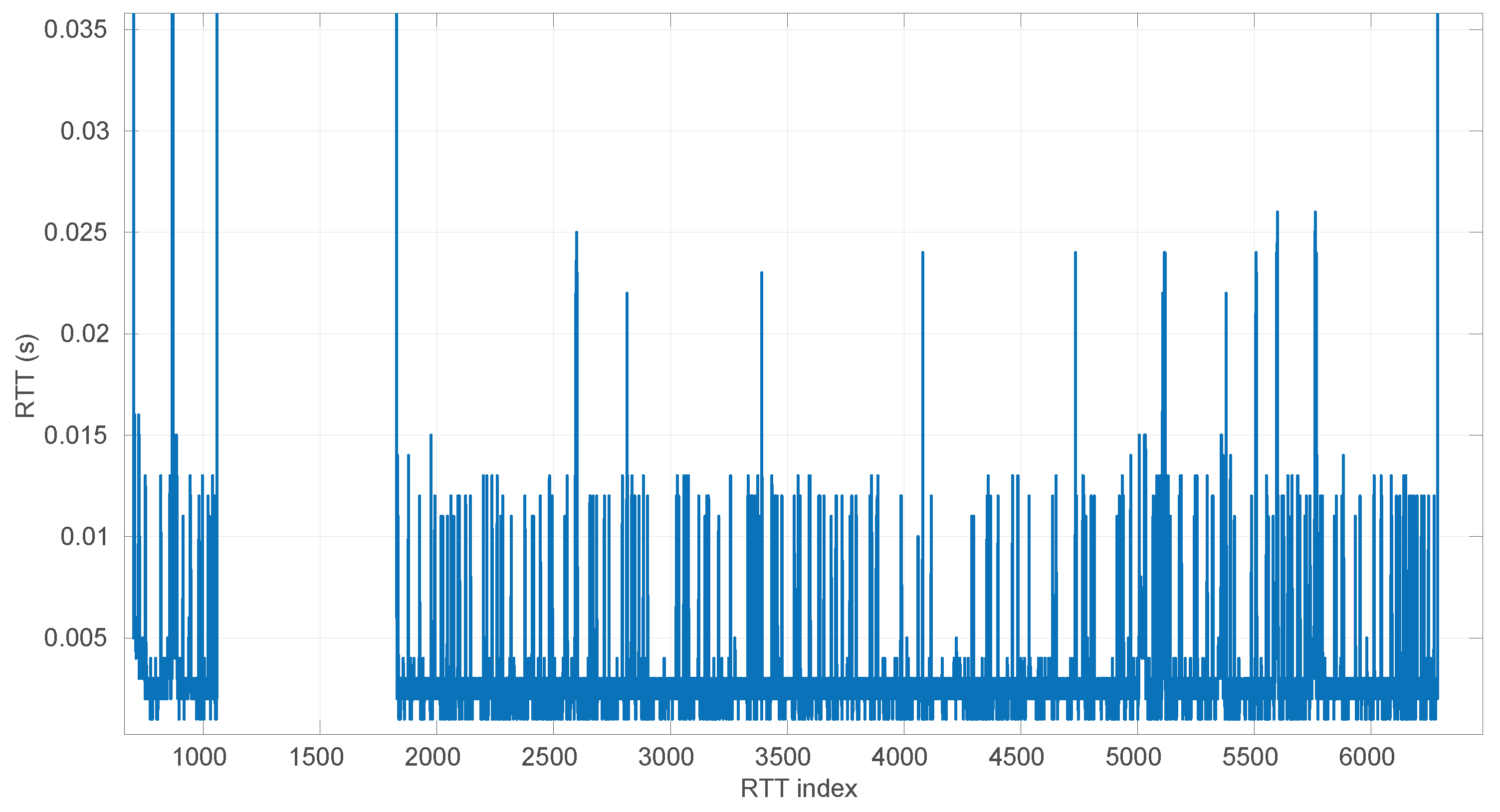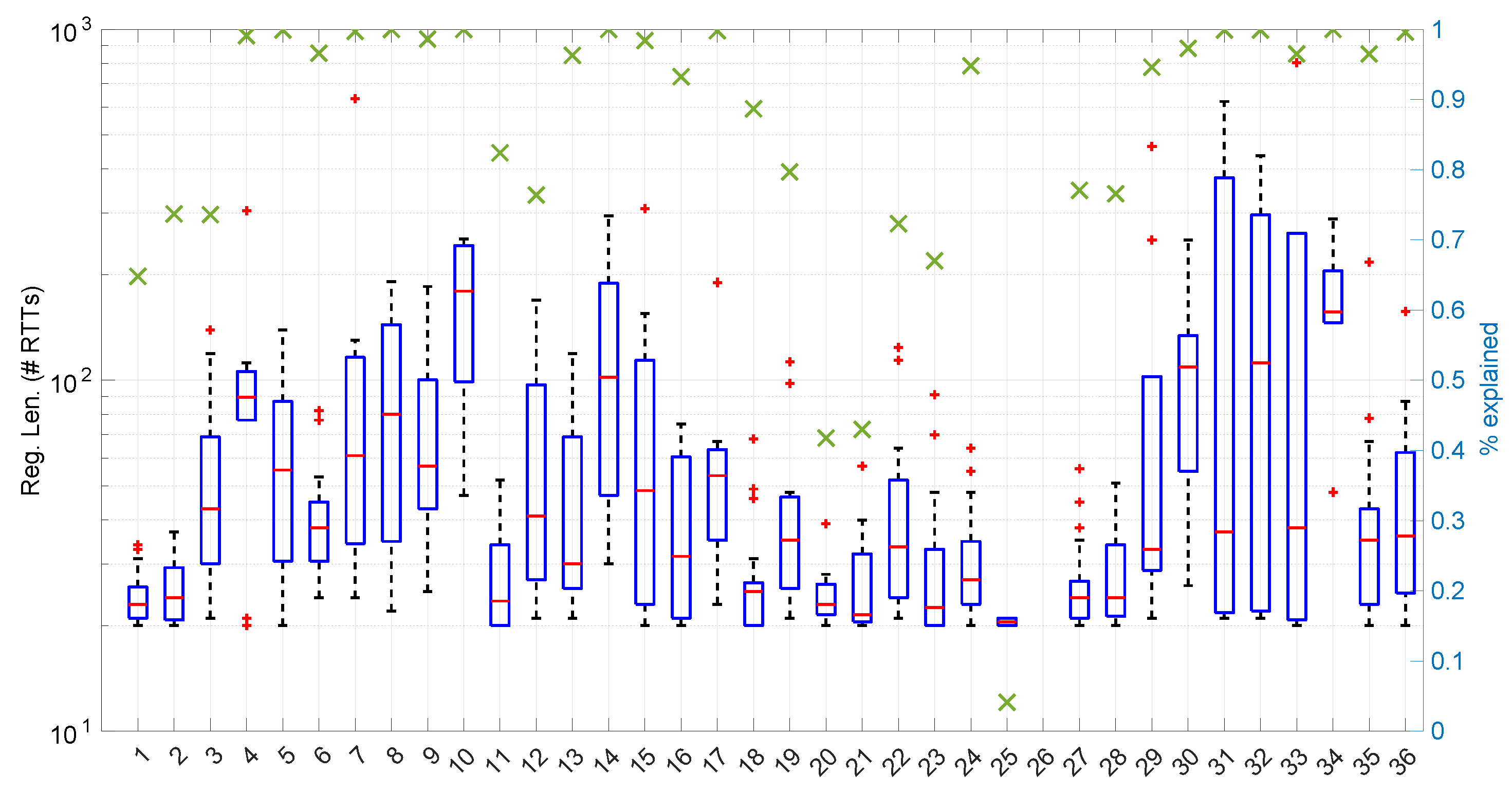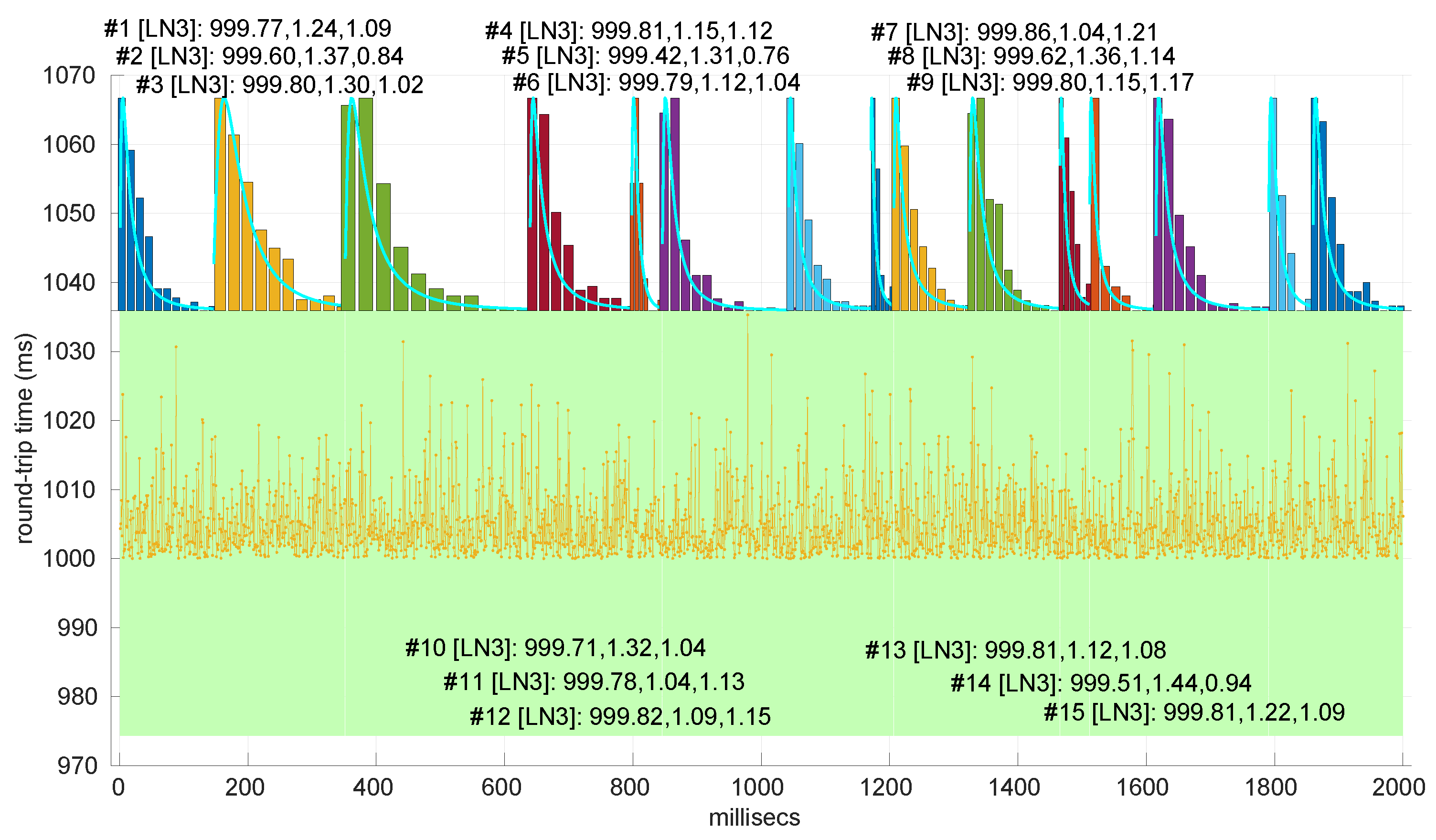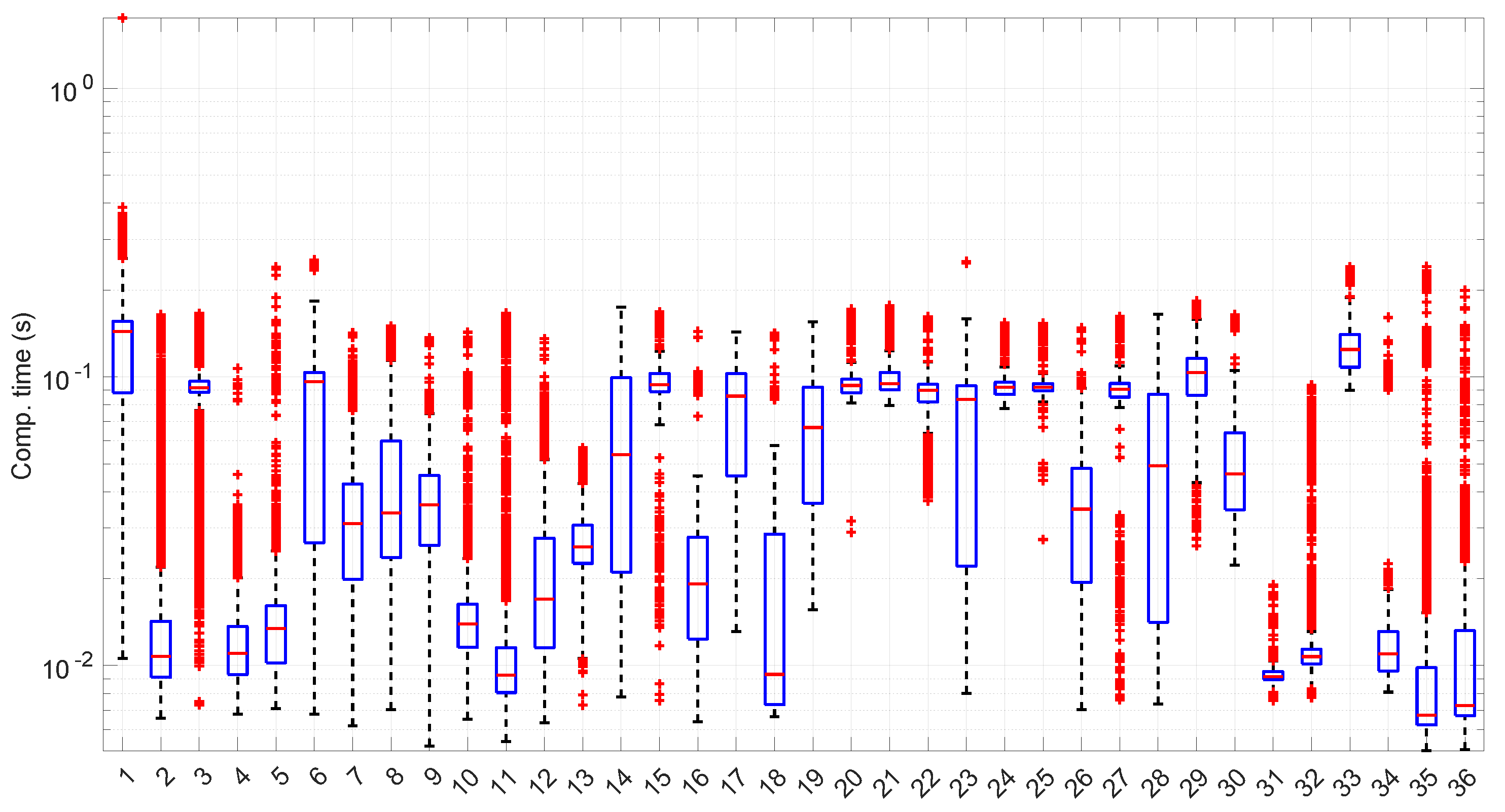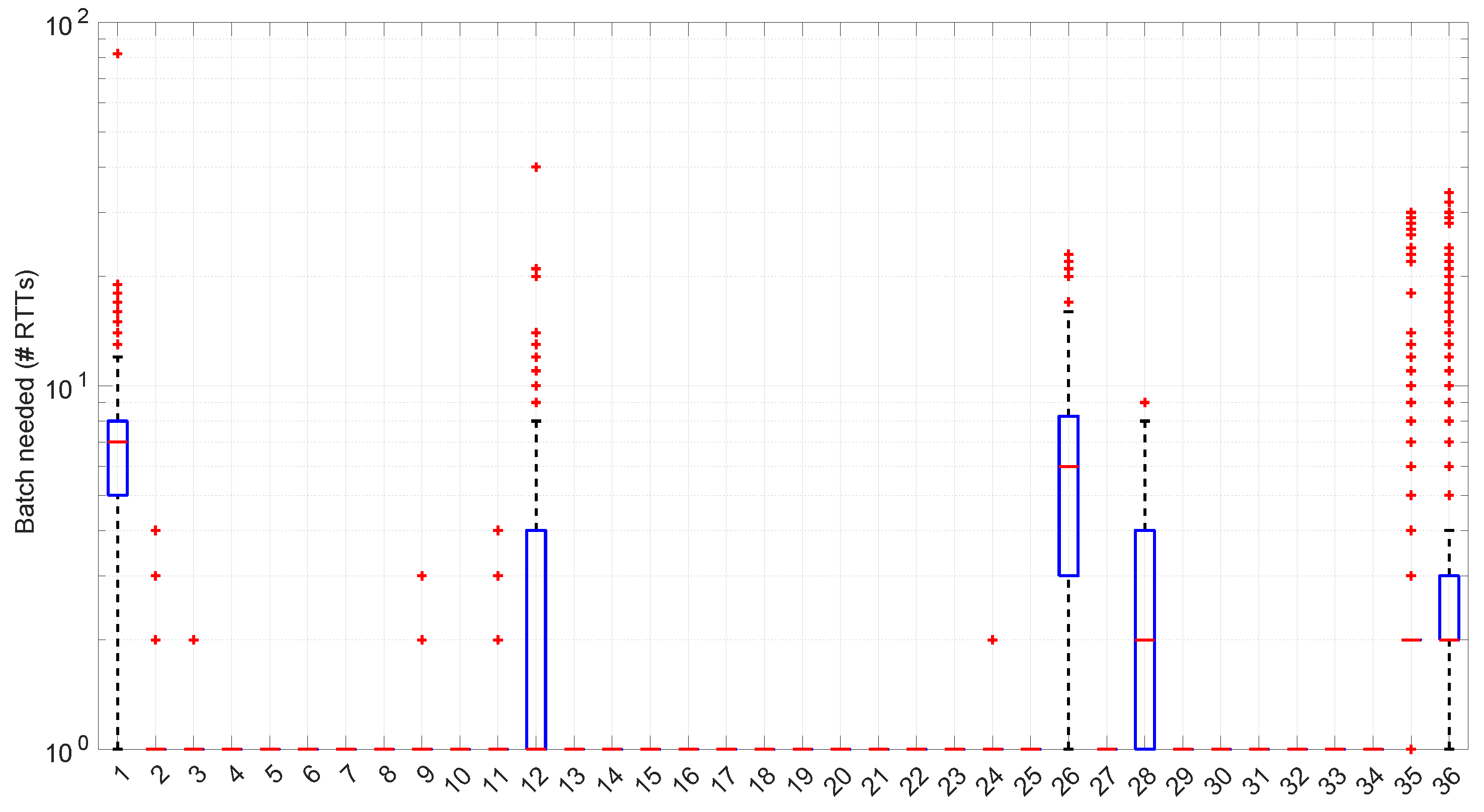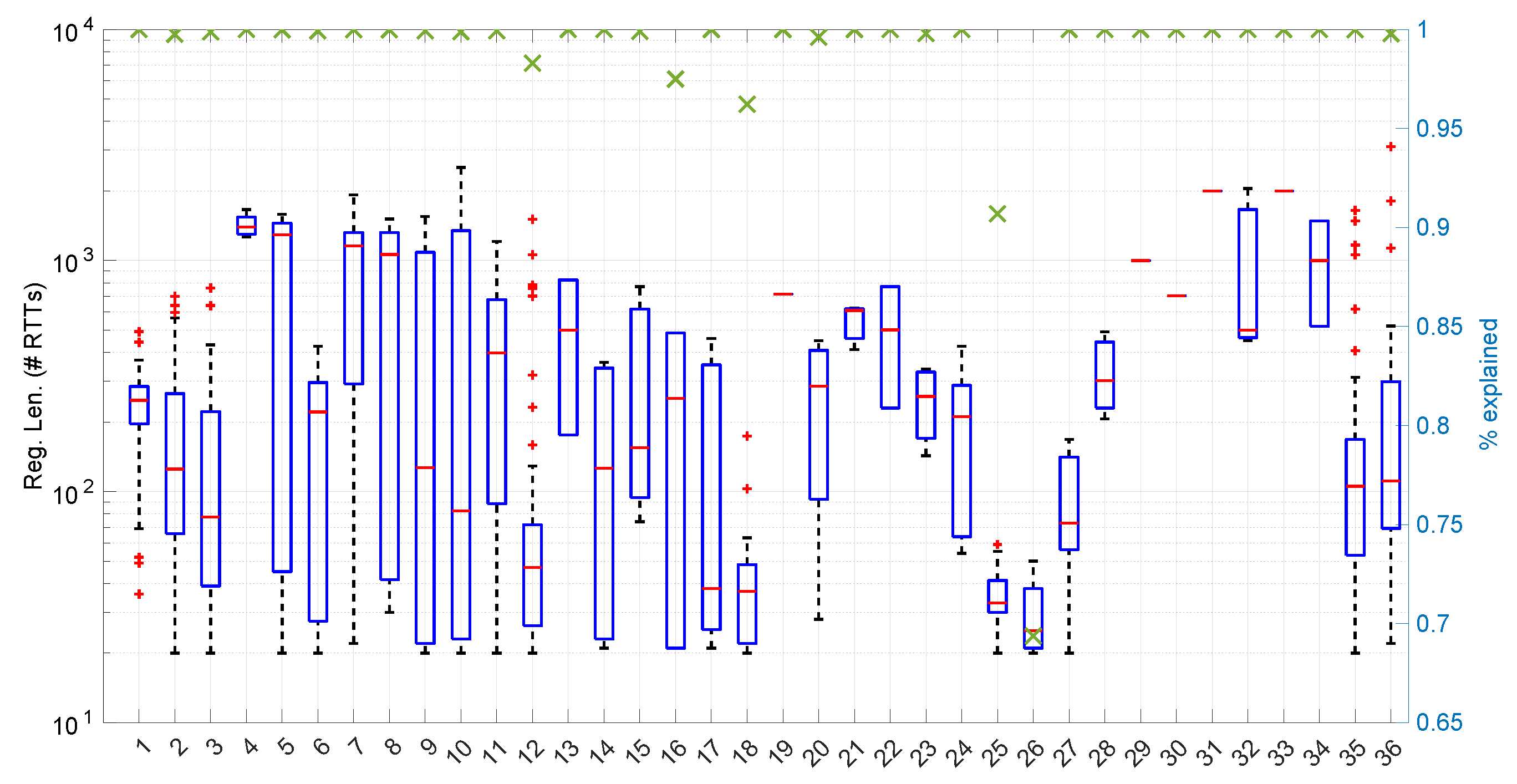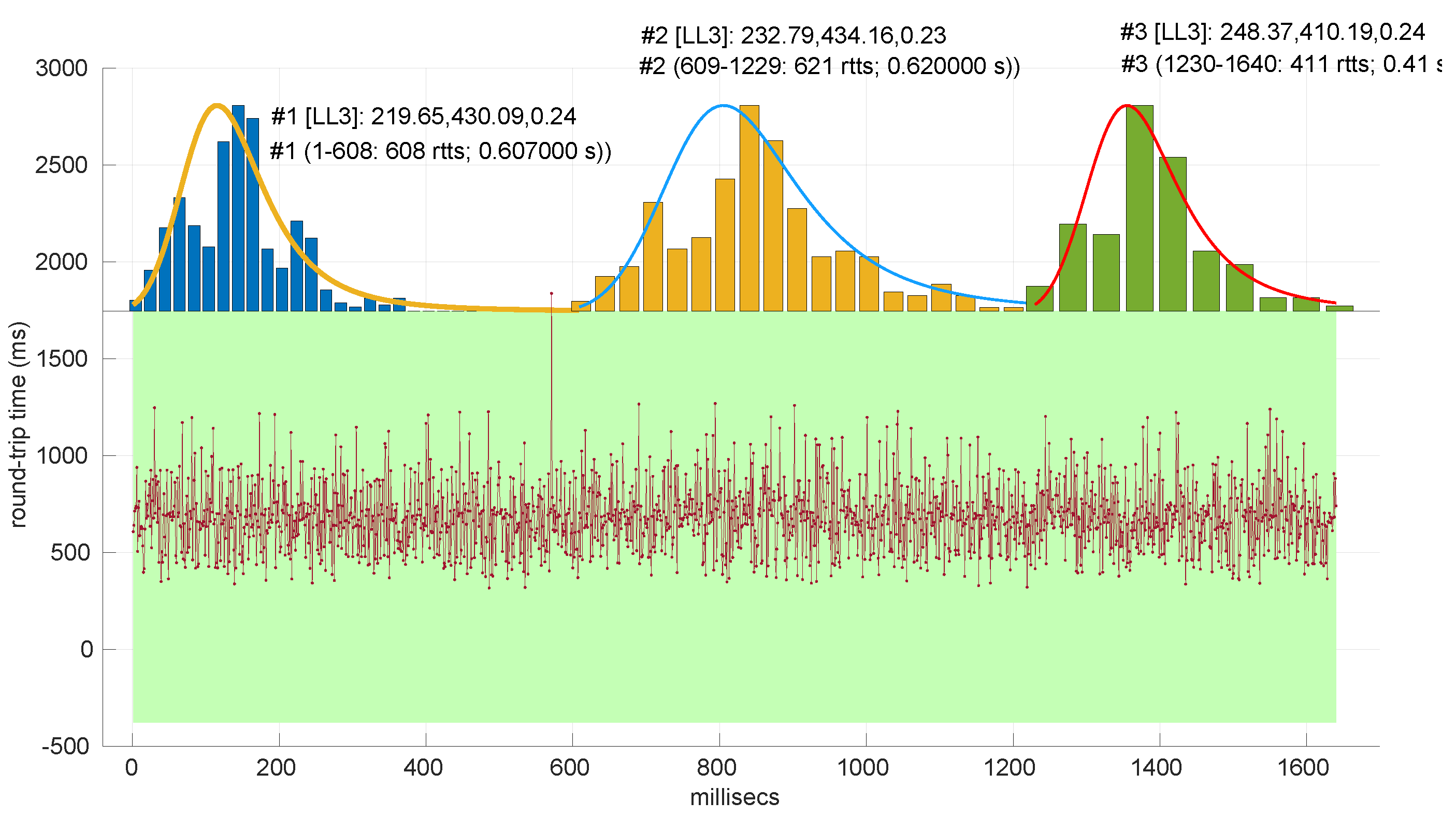1. Introduction
The correctness of computing systems that are distributed over a network depends directly on dealing with time, in particular on their capabilities for both synchronizing clocks that tick with different frequencies and offsets [
1] and dealing with the delays involved in their exchange of information [
2]. Regarding the latter, there are a number of methods that model statistically those delays, but many of them impose requirements that do not fit well the problem of sensory transmissions in networked robots [
3]. These particular scenarios demand online processing of the measured times, as opposed to offline approaches; they must account not only for network latency but also for delays introduced by software; they are required to provide rich information about the behaviour of RTTs, and they usually have no mathematical model available for the dynamics of the system (plant) to be controlled.
In that kind of setting, one or more robots need to transmit data (the bulk comprising sensory data) to remote computers that process them and make decisions to be executed on board. This forms a control loop [
4] where each iteration takes a stochastic time, referred here to as
round-trip time (RTT) and may affect the stability and quality of the robot’s performance.
Notice that in other communities, there are diverse definitions of RTT. In our context that time comprises both hardware (network + sensors + computers) and software (drivers + operating systems + applications) delays, all of these components provide some part of the total cycle time, and, in most cases, none of them satisfy hard real-time requirements [
5]. Nevertheless, even a non-deterministic, probabilistic modeling of these round-trip times is important for the correct operation of the robot, e.g., for assessing the probability that the next round-trip time lies within some interval.
In this paper we deal with marginal modeling of these round-trip times aimed at providing a reasonable computational cost for fully or at least batched online processing, which provides more information about the RTT sequence than just the expected next measurement, and a simplified representation of the gathered RTTs as close as possible to the actual data.
Marginal modeling, by definition, is carried out based on particular probability distributions. Diverse distributions have been proposed for network transmissions: The
Exponential model, which is a general and common representation of independent inter-arrival times, is useful for fast communications, for instance, among networked sensors [
6] and also as a limiting distribution when the load in the network increases, since it is closely related to Poisson processes [
7]. The
Log-normal distribution is used for modeling the traffic in wired networks (LAN) [
8], which provides more flexibility than the exponential through an additional parameter, and other distributions as well, such as
Weibull (which generalizes the
Exponential),
Erlang (a product of
Exponentials), and
Gamma (a further generalization of the
Exponential) [
9]. Remarkable flexibility in a marginal modeling context has been shown by the
Log-logistic model [
10], mainly due to its heavy tail and variety of shapes.
In addition, a number of general change detection methods that can be applied to the detection of abrupt regime changes in the RTT sequence exist in the literature [
11,
12,
13]. However, many of these (i) require access to future data windows, leading to additional delays in detection—; (ii) do not offer rigorous statistical guarantees; or (iii) do not assume a particular parametric distribution of the data that carries out enough information about the RTTs and converge to the correct model with short samples.
On the other hand, performing a goodness-of-fit hypothesis test is a rigorous approach [
14,
15] that, through the rejection or not of the hypothesis that the current distribution explains the last round-trip times, serves to detect changes in regimes, and it works without knowing any further data and provides more accurate modeling due to the assumption of a particular, well-defined probability distribution. Elsewhere we have applied it to the case of the
Log-logistic distribution [
10], but without a thorough analysis of its statistical performance.
Here we study in depth the use of goodness-of-fit hypothesis tests for the main marginal probability distributions used in similar problems. Note that the networked robot context has certain particularities that define special requirements not always found in other studies:
To have a location parameter in all these distributions.
To use suitable ranges of all their parameters.
To consider possible numerical errors in the computations.
To employ parameter estimation procedures adapted to all of that.
To have a rigorous assessment of the performance of the goodness-of-fit tests, in particular their significance and power, under those conditions.
This lead to some modifications in the classical tests in order to preserve their significance and power as much as possible. Once assessed, these tests can be applied to the detection of changes in regimes using the following null hypothesis:
: The current sample of the sequence of round-trip times has been generated by a given form of (current distribution model).
In the case the hypothesis is rejected, a change of regime can be assumed. The sample can grow as long as new round-trip times that do not reject the hypothesis are added, possibly re-estimating the parameters of the distribution along the way.
For this work we have used an extensive dataset of round-trip times collected in diverse networked robot scenarios [
16]. It has been served both for defining the suitable parameter ranges for the distributions and for assessing the performance of both the parameter estimation and goodness-of-fit procedures. Our results confirm that particular adjustments on existing methods are needed for this kind of systems; we also report comparisons between the studied distributions.
In summary, the main contributions of this paper are as follows:
New modified Maximum Likelihood Estimators for the three probability distributions that are common in marginal modeling of network communications, which are aimed at coping with the particular issues found in the context of networked robots’ round-trip times modeling.
A statistical evaluation of the effects of the discretization of time performed by computers in the estimation of parameters of those continuous distributions.
Novel Monte Carlo estimates of the thresholds corresponding to a significance level of 0.05 for the well-known Cramér-von Mises goodness-of-fit test in the case where the parameters of those distributions are estimated from the sample using our modified MLEs.
Smooth polynomial interpolations of the obtained thresholds that enable compact and relatively fast calculations with any sample size.
A statistical assessment of the significance and power of the GoF tests with the provided thresholds.
Experimental evaluation of the use of our tests for modeling both real and synthetic sequences of RTTs in networked robot applications, including their computational cost, their online modeling capacities, and their ability to detect abrupt changes in regimes.
The rest of the document is structured as follows: In
Section 2 we summarize the main trends dealing with stochastic RTTs in the literature; in
Section 3 we provide the formal definitions of the three analyzed models; in
Section 4 we describe the procedures to estimate their parameters from round-trip samples, and in
Section 5 we study the hypothesis tests devised for them. In
Section 6 we evaluate the performance of our procedures on the dataset. Finally, we include the main conclusions and future work.
2. Related Work
In the following section we classify the main RTT characterization methods that can be found in the literature, though the specific goals can differ from one work to another depending on the context.
Communication networks are the main community dealing with round-trip times, which are a central metric in performance evaluations and usually comprise the network components only. Their specific definition and therefore the techniques used to model them mostly depend on the layer of the communication stack where they are measured—e.g., at the low levels of the ISO stack, which is close to the network hardware, RTTs can be modeled and predicted with the methodologies listed in [
17].
Statistics offers a set of simple and powerful techniques to model and predict round-trip times. For example, there is a well-known statistical expression that estimates RTT occurring in the TCP protocol, namely the Exponentially Weighted Moving Average (EWMA) [
18]:
where
is the current measured RTT and
the estimated one, computed over time. The parameter
is usually assigned a value of one-eighth, according to RFC 6298 [
19], which leads to certain loss of adaptability. In general, the EWMA is a simple methodology and can be run fully online, but since it acts as a smoothing filter, it does not provide fast detection of abrupt changes in the RTT values nor a complete model from which other deductions can be drawn (e.g., what is the probability of the next RTT lying in a given interval).
With the goal of analyzing the end-to-end latency in different geographical areas of the world and its implications on networking services, ref. [
20] uses linear regression models—seeking the RMSE in the regression lines—based on RTT data collected worldwide through a span of several years. These are implemented in ML libraries written in the most common programming languages. However, their approach is completely offline and does not consider bursts or regime changes in the transmission; furthermore, their definition of round-trip time does not include the access from the user computer to the network.
Another statistical approach is the one where [
21] applies to industrial environments, with the aim of minimizing the impact of undesired delays in the performance of the control loops of a plant. The authors of [
21] use an ARIMA-based solution to model and then predict (point prediction) the network delays; this prediction is then combined with the use of specific algorithms that help to manage the effects of those delays in the loops. ARIMA prediction of network traffic is still a matter of research, particularly if hybridized with neural networks [
22,
23]; however, this is an offline approach that requires a large amount of training time and data.
The work in [
24] focuses on the congestion control at the TCP level. The authors have designed a CUSUM Kalman Filter, an adaptive filter that detects abrupt changes in RTT. This filter needs a basic model of the network nodes, whereas our approach does not require any previous model. Again, recent research also tends to hybridize CUSUM with neural networks, though it is mainly applied to the detection of abnormal traffic conditions in communication networks [
25]. A different congestion control strategy for mobile networks is the one in [
26], which uses a two-stage Kalman filter plus an adaptive clipping phase but also depends on the availability of a network model.
Closely related to Kalman Filters, Hidden Markov Models (HMMs) [
27] are another option for RTT estimation. They are able to grasp the time dependencies in a sequence of time measurements and abrupt changes in regimes, but these benefits come at the expense of a significant computing cost for training the model. In particular, ref. [
28] uses a Hierarchical Dirichlet Process HMM (HDP-HMM) to predict RTTs in the long term with a precise identification of changes and bursts in the signal. The model has a computation time of 5 s; thus it has to be recalculated at regular intervals; i.e., it works in batches of RTTs. In a robotics application like ours, the robot would work in an open loop from the previous model’s update for at least those 5 s, which can lead to a dangerous situation if in the meantime there is a downgrading or regime change in the transmissions. Other recent works on the use of HMMs in communication networks exist, but they usually deal with detecting abnormal conditions rather than modeling/forecasting transmission times [
29].
Recently there is an important trend to use machine learning techniques that, in general, provide fewer guarantees but better adjustment to complex situations for modeling round-trip times. In [
30] the RTT is estimated using Regularization Extreme Machine Learning (RELM), which combines the training speed of ELM networks without overfitting issues thanks to the regularization part of machine learning. It obtains accurate RTT estimations with good time performance in the validation and testing phases, but there are no results of a real implementation that deals with bursts or regime changes. There are also deep learning approaches for RTT estimation. In this area, the authors of [
31] propose a recurrent neural network (RNN) with a minimal gated unit (MGU) structure in order to predict RTTs; this solution obtains very good results when compared with some other RTT modeling techniques; however, it does not present information about the power and time resources needed neither for the initial offline RNN training phase nor for the performance of RTT prediction on the fly. The work in [
32] presents a DL classic strategy with a LSTM-based RNN architecture that passively predicts RTT in an intermediate node (therefore not in the transmission endpoints, as seen in our approach) that can be trained on an experimental testbed and then delivered without accuracy loss to a real environment; i.e., it shows good transfer learning capabilities. However, again there is no information about the costs of the training phase, and there are no real tests with abrupt changes in the transmission time. Also working on the modeling and prediction of RTT at the TCP level, ref. [
33] reports a Transformer-based solution in a preliminary stage but with good results. As in previous cases, that demands a previous training phase of which there is no information about its time and power costs, and its performance in a real setting with bursts and changes in regimes is unknown too. Notice that these approaches mostly provide a prediction of the next round-trip time only.
Most of the mentioned methods address the dependencies existing between successive round-trip times and try to model these dependencies as accurately as possible, usually without achieving complete online performance in a real system and in many cases without explicitly handling abrupt changes in regimes in the signal. A different approach is to drop those dependencies and deal with the data as though they were iid, i.e., samples drawn from some marginal probability distribution. As long as abrupt changes in regimes in the sequence of round-trip times are detected, and different models are fitted to each regime, this approximation may provide good results with less computational costs than other methods, and since they are based in particular probability distributions, they also serve to not only draw different conclusions from the data but also to point value forecasting; they can also be adapted to online estimation quite easily. The main reason for their good behavior is that the round-trip times in real systems have little trends, as they are composed in most cases of segments of different characteristics that are stationary.
5. Goodness-of-Fit Tests
In the literature, we can find a significant number of goodness-of-fit methods based on statistical hypothesis testing [
35]. In general, these methods first calculate a given statistic from the sample at hand, based on the assumption that the sample comes from a certain theoretical distribution (
). Then they evaluate the probability that the statistic takes the calculated value or a larger one if the assumption is true—a right-tail test; if that probability falls below a given significance level
or, in other words, if the statistic value is equal or larger than a certain threshold
, then the null hypothesis can be rejected.
Elsewhere we have shown the good performance of the Anderson–Darling statistic in the case of the
Log-logistic distribution, with it being one of the best marginal models for round-trip times in networked robot settings [
10]. However, we do not use it here due to the limitations discussed in the following section.
Recall that the Exponential distribution can produce values that fall exactly at the location with non-zero probability. Although the theoretical Log-normal and Log-logistic distributions cannot do that, it is possible in practice to obtain values exactly equal to the location of those distributions due to numerical errors and the discretization of round-trip times. As shown below, the statistic to be computed for the Anderson–Darling test cannot handle those cases well (singularities occur), and that produces failed tests. In this paper we use the Cramér-von Mises statistic; with only slightly less power, it deals naturally with that issue and thus improves the applicability of the test.
Both the Anderson–Darling and Cramér-von Mises tests belong to the class of the so-called EDF statistics, which are based on computing the experimental distribution function (EDF) of the sample and then testing the difference with a theoretical distribution. In particular, they follow the pattern for a general quadratic statistic defined as
where
is the experimental distribution function,
the theoretical one, and
is a weighting function.
The Anderson–Darling and Cramér-von Mises tests instantiate the weighting function
differently in order to obtain the so-called
and
statistics, respectively, where
Note that the Cramér-von Mises test gives the same importance (weight) to all the parts of the support of the variable, while for the Anderson–Darling test, the tails, either where or , are more important.
To derive the specific expressions for these statistics, we begin by applying the Probability Integral Transform; if
is the true (continuous) distribution function of the data, then
; i.e., the result of applying that function to the sample should follow a standard
uniform distribution
. Furthermore, it turns out [
35] that the differences
equal the ones required by Equation (
12),
. Applying this result, if we arrange
Z in increasing order, i.e.,
, the following statistics are obtained:
where it can be observed that the suitability of is
for cases where some
is 0 or 1, unlike
.
If the sample actually comes from the proposed theoretical distribution (i.e., if holds) and that distribution is completely known in advance, that is, no parameter estimation is needed, then Z will certainly follow the cdf of , a straight line with a slope of 1 and an intercept of 0; otherwise, when the parameters of the distribution are estimated from the very same sample, Z will no longer be uniform, and the distribution of the statistic () can have, in general, any arbitrarily complex shape; it will depend on the particular parameter estimation procedure, the sample size, and the theoretical distribution being tested.
There exist numerical tables for this kind of statistic, for which in some cases, Equation (
14) has to be slightly modified, but since we use modified parameter estimation procedures in this work (
Section 4), we need to provide new deductions of the thresholds for the tests. We do that through extensive Monte Carlo simulations starting with a minimum sample size of 20 up to a maximum size of 10,000.
The goodness-of-fit test for the
Exponential distribution is the simplest one. We transform the sample
X through the cdf of Equation (
2) and then calculate
from Equation (
14). In [
35] tables are provided for the thresholds to check. In
Table 1 we collect the modifications of
and the thresholds to use for the case of
, which we confirmed in our Monte Carlo experiments.
The tests for the
Log-normal and
Log-logistic distributions are the same as in [
35] for the case of not estimating the parameters from the sample; we transform the data into another sample that is assumed to be drawn from
by means of the Probability Integral Transform and then use the definition of the
statistic in Equation (
14) and the first row of
Table 1 to complete the tests. The procedure is as follows:
In the case of the Log-normal distribution, we transform the data into through , then into a standard normal distribution through , and then apply the corresponding cdf, i.e., .
In the case of the Log-logistic distribution, we first transform the sample into a non-located Logistic distribution with , then apply the cdf of the Logistic distribution, which is . Another common formulation for the Logistic distribution takes and as parameters.
However, since we proposed variations in the MLE procedures when the parameters are estimated from the sample in this paper (the semi-biased variation in the Exponential estimators, the extension of the Cohen’s method for the Log-normal distribution in Algorithm 1, and the two-stage non-linear optimization procedure with particular bounds on the allowed values of the parameters for the Log-logistic distribution), we need new mappings of the thresholds.
For that purpose, we processed a number of real experiments, which are publicly available at Zenodo [
16], that contain sequences of round-trip times measured in a diversity of real environments where a remote computer requests sensory data from typical robotic sensors. This dataset contains sequences of RTTs, which are defined as in this paper, that involve communications between continents or local (same computer), transmissions of amounts of sensory data that are very diverse (from a few bytes to complete color camera snapshots), different operating systems and applications both in the client and server sides, and also widely different computer power (from simple embedded microcontrollers to high-end PCs); therefore we consider them to be quite representative of the diversity of situations that can be found in the context of networked robots.
We scanned all these time series by defining a window of a certain length
w that moves along each round-trip-time sequence with increments of 10 at each step; for each window placement, we collect the corresponding round-trip-time sample and carry out parameter estimation on it for the three distributions defined in
Section 3 using the procedures of
Section 4.
Once all experiments were scanned with window sizes
, the estimated parameters for the considered distributions are collected, and the lower and upper bounds are determined for each of them. We consequently consider those bounds highly representative of very diverse situations of networked robots, and they are therefore suitable for carrying Monte Carlo simulations that draw values uniformly from the intervals they define.
Table 2 lists these bounds. Actually, the distributions we build using those bounds cover much more cases than the ones likely producing the dataset, since we use all possible combinations of the parameters within the given ranges freely, without any restriction.
We estimate the thresholds
for the goodness-of-fit tests of the
Log-normal and
Log-logistic distributions by generating random distributions of those types using the mentioned bounds, drawing a number of samples of each given size from them, and then collecting the statistic
that the tests would produce in that case. Note that we use the modifications suggested in [
35] when all parameters are estimated from the sample:
for the
Log-normal distribution and
for the
Log-logistic distribution.
Since the samples are generated from the distribution to be tested,
holds; therefore, we can use the histograms of the collected statistics
to deduce the threshold needed to decide a rejection under a given significance level (
) and sample size: that threshold has to leave to its right that area. For that purpose, the
quantile of the collected statistic values is computed.
Figure 2 illustrates an example of the obtained threshold for the goodness-of-fit test of the
Log-normal distribution with a sample size of 200.
When this process is repeated for a number of sample sizes, we obtain a threshold () for each one; plotting all of them together versus the sample size reveals the pattern to be used in the test.
Figure 3 and
Figure 4 show the resulting threshold patterns for both the
Log-normal and
Log-logistic distributions when considering
and sample sizes in the interval [20, 10,000]. We carried out the Monte Carlo simulation for finer resolutions of sample sizes in the range
because those sizes are expected to occur more frequently when modeling this kind of time series. Notice the higher variance in the thresholds for the
Log-normal case, likely due to the higher variance in the estimation of parameters through the method of moments versus MLE.
The execution of these experiments is computationally intensive. To reduce the overall time employed in completing all the experiments, we distributed them among several machines and run them in parallel:
IMECH: A high-performance workstation equipped with 4 NVIDIA RTX A6000 48 GB GPUs and an Intel Xeon Gold 5317 processor featuring 48 threads. It is provided by the Institute of Mechatronic Engineering & Cyber-Physical Systems [
45] of the University of Málaga.
darkstar: A high-performance workstation equipped with one NVIDIA RTX 5070 Ti 16 GB GPU and an AMD Ryzen 7 9800X3D processor featuring 16 threads.
garthim2: A desktop computer equipped with an NVIDIA GeForce GT 710 GPU and an Intel(R) Core(TM) i9-10900KF CPU, offering 20 threads.
In order to use the patterns of
Figure 3 and
Figure 4 efficiently in practical implementations of goodness-of-fit tests, it is convenient to find analytical forms for them. Due to the different shapes that are shown in the figures for different parts of the sample size space and the need to provide a formula that minimizes the error with respect to the actual measured thresholds, we partitioned the data and fitted a different curve
to each part through a non-linear search of the minimum mean square error; then, adjacent parts of the curves were welded pairwise using sigmoid weights
.
More concretely, if we have two consecutive parts,
and
, defined, respectively, in the intervals
and
, with
, we can calculate their welding at points
as
In the case of an s value that lies in the first half of the first part or in the last half of the last part, no welding is performed and the corresponding part is directly evaluated.
The sigmoid weights are defined as follows:
where the function yields weights in
,
x is the particular sample size,
k the smoothing constant, and
T is the joint point (a certain value in the sample size space). The sigmoid yields
at the joint point, thus giving the same weight to both adjacent parts at that place. The constant
k is calculated in order to reach some weight
(e.g.,
) at a distance
from the joint point equal to 1/5 of the length of the shortest part, causing a fading effect of all welding relatively close to each joint point; for that condition to hold,
, according to the definition in Equation (
16).
The partition of each threshold pattern was performed visually by looking for the best segments that fit the polynomials, i.e., the familiar 1st-, 2nd-., or 3rd-order shapes. After deciding the points at which such shapes would change substantially, the search for the best polynomial for each segment was conducted through MSE fitting by attempting to solve the trade-off based on the following criteria:
Small fitting residuals were usually improved by increasing the degree of the polynomial, but only to a point before producing overfitting.
Fast calculations in their implementations were improved by decreasing the degree of the polynomial.
The close placement of ending points results in the case where two polynomials have to be welded together.
On some occasions we repeated this search of a suitable trade-off after obtaining a complete welded solution because it was not completely satisfactory from a global perspective, i.e., considering all the segments at once.
Figure 5 illustrates the resulting analytical form for the case of the
Log-normal distribution. Two parts that can be fitted with the following polynomials and welded using
are distinguished:
Notice the very small values of some coefficients in some parts of Equation (
17); we kept them because their presence improves the welding at the joint point, which is quite sensitive as discussed later on.
A similar procedure was followed to provide an analytical form for the pattern of the threshold
in the case of the
Log-logistic distribution.
Figure 6 shows the resulting curve.
We distinguished three different parts here:
The welding is conducted as in the Log-normal case but with .
We found that the sensitivity of the welding to the value of
is quite high; in
Figure 7 we show the effect of reducing
in the first joint of the
Log-logistic threshold approximation.
6. Evaluation
The first assessment of the proposed methods for modeling regimes in sequences of round-trip times is concerned with their power and significance. To test both, we conducted extensive Monte Carlo simulations of the distributions we defined in
Section 3, taking their parameters uniformly from the intervals we identified in
Table 2.
We also include in this section the study of the effects of the discretization of time measurements on the estimation procedures (
Section 6.2).
Finally, we used the three models in all the scenarios of the previously mentioned dataset to find different regimes by gathering some measures that allow us to assess their utility and compare them.
6.1. Significance and Power
For assessing the level of significance, we generated 10,000 random distributions of each type (
Exponential,
Log-normal, and
Log-logistic) and drawn a sample from each one until a successful estimation of the distribution parameters is obtained for the sample; then we run the goodness-of-fit procedure described in
Section 5 and counted how many times the test rejects the hypothesis
(which we know is true), that is, the proportion of type I errors. The obtained expected
levels are very close to the designed
, regardless of the sample size. Histograms of these
levels are shown in
Figure 8.
On the other hand, the power of the tests is influenced by the sample sizes. We assessed this using several alternative hypotheses: Exponential, Log-normal, Log-logistic, Trunc-normal, and uniform. Trunc-normal has zero probability of producing values below certain locations (we cannot work with an infinite support in a networked robot) and has a normal shape beyond that point. For all of them we scanned sample sizes from 20 to 10,000 round-trip times and draw 10,000 samples randomly from the alternative distribution (randomly generated as well), ensuring that the parameters of the target distribution can be estimated, and then we counted the number of rejections of the null hypothesis.
Figure 9 shows the results for the
Exponential goodness-of-fit test. It can be seen that this test is more discriminative for
uniform samples (a power of
from samples of size 35 onward) than for the
Log-logistic (from 55 onward) and
Trunc-normal (from 80 onward) samples; when the sample comes from a
Log-normal distribution, the test shows a consistently high power, but not as high as for the other distributions in the case of large samples. The parameter estimation procedure for the
Exponential distribution cannot fail.
In
Figure 10 we show the power for the
Log-normal goodness-of-fit test. This test is highly discriminative for the
Trunc-normal and
uniform distribution, being >0.9 for all sample sizes, and less for the
Log-logistic distribution, being >0.9 only from sample sizes of 4300 and up. This is mostly due to the natural closeness in shape of both distributions, but the non-negligible noise in the experimental thresholds of the
Log-normal distribution can also have an effect. The practical consequence is that shorter
Log-logistic samples will often be considered as
Log-normal by this test. Designing a better procedure to estimate the thresholds (or to reduce the noise in their Monte Carlo calculation) is left as future work.
In our experiments, the procedure for estimating the parameters of the Log-normal distribution from the samples never failed to provide models to be assessed by the goodness-of-fit test.
Figure 11 shows the power curves for the
Log-logistic distribution. The power of this test is similar to that of the
Log-normal distribution but better with respect to that distribution (i.e., the
Log-logistic distribution has more discriminative power for
Log-normal samples than vice versa) and worse regarding the
Trunc-normal,
uniform, and
Exponential distributions. The only abnormal issue is in this last case, where the power is kept low from sample sizes of
approximately, which coincides with the first part of the threshold pattern curves in
Figure 6. Therefore it is likely that the procedure to fit polynomials to those thresholds and/or the calculation of the thresholds itself through Monte Carlo could be improved. Nevertheless, the capabilities of the
Log-logistic distribution for modeling and assessing regimes in sequences of RTTs is far superior to the ones of the other distributions, as we will see in
Section 6.3.
As in the case of the Log-normal distribution, in our experiments, the procedure for estimating the parameters of the Log-logistic distribution from the samples never failed to provide models to be assessed by the goodness-of-fit test.
6.2. Effects of the Time Resolution on Parameter Estimation
As explained at the beginning of
Section 4, round-trip times are measured as discrete values, while our models have continuous support. This may produce additional errors in our procedures, particularly during the estimation of parameters of the distribution corresponding to a given RTT sample. Note that in all the scenarios of the dataset used for our experiments, the time measurement resolution is of nanoseconds (a common clock resolution in modern CPUs), and when synthetic samples are drawn from distributions, the numeric resolution is set to ∼
, i.e., up to 16 decimal digits; thus we avoid these errors in the experiments reported in other sections of the paper.
For a more in-depth analysis of the possible effects of having lower resolutions for time measurements, we generated 40 random samples from the three distributions described in
Section 3 using parameters chosen also randomly from the ranges listed in
Table 2; we then rounded the RTTs of each sample to a given resolution from a range covering from nanoseconds to milliseconds (which represents the vast majority of time-measuring systems that exist); finally we run the corresponding MLE procedure on the adjusted resolution sample. In this way, we can gather a statistical distribution of errors in the MLE-estimated parameters with respect to the true ones that produced the samples, as well as with respect to the ones that would be estimated with the maximum resolution (16 digits). We repeated the same process for each time resolution using sample sizes from 20 to 10,000 in steps of 100.
To maximize the generality of this analysis, the error metric should be relative to the magnitude of the true value of the parameter being estimated and also relative to the error obtained when using the maximum resolution. For that purpose, if
is the true
i-th parameter of the distribution that generated the sample, where
is its estimation with time resolution
r and
is its estimation with the maximum time resolution, we calculate the normalized, relative error for that sample as follows:
According to this definition, a positive error indicates that the estimated parameter is larger than the true one, while a negative error indicates the opposite; the absolute magnitude of the error is the most important metric. Since we draw multiple samples, we obtain a statistical distribution for the error at the end.
The first conclusion of this study is that the sample size has no statistically significant influence on the error, in any of the models we analyze in this paper. This allows us to focus on the study of the effects of time resolution on a single sample size, which we have set to 100, and thus use a larger number of samples, namely 1000.
After calculating the normalized error per time resolution with a sample size of 100, it is clear that decreasing the time resolution produces more and more probability of having larger errors in the estimation, as shown in
Figure 12,
Figure 13,
Figure 14,
Figure 15,
Figure 16,
Figure 17,
Figure 18 and
Figure 19. The effect is particularly important in the
Exponential and
Log-normal distributions, with
Log-logistic being much less sensitive to worse time resolutions. For a practical summary, the probability of having high errors becomes relevant when the resolutions become lower than the ones listed in
Table 3. Notice that with a resolution of nanoseconds, which is common in modern OSes, there should be no special problems in those procedures.
6.3. Round-Trip Times Modeling in Networked Robot Scenarios
Besides assessing the significance and power of the three models and procedures proposed in this paper, we also evaluated their performance when modeling different regimes in the dataset of scenarios already introduced and described with more detail in [
16].
In
Figure 20, we summarize the statistical characteristics of the RTTs of all the scenarios of the dataset, where the skewness and long tails of their statistical distributions can be clearly appreciated, even with the logarithm scale used for a clearer visualization of the quartiles.
All the results that follow have been obtained based on all the scenarios of the dataset, but to explain some particularities of the methods, we have selected a few scenarios, as listed in
Table 4. That table can serve as an index of the figures shown later on for those individual scenarios.
In
Figure 21 and
Figure 22, we show two scenarios in detail, where abrupt changes in regimes are visually very clear. In
Figure 21, we also highlight some short trends appearing in the data of one of those scenarios. These effects are very rare—we have detected them only in three of our scenarios, and they are always very short. As it can be seen in the results of detecting regimes on this scenario with our three models (
Figure 29,
Figure 40 and
Figure 47), in most of these situations, specifically when using the
Log-normal and
Log-logistic models, trends are absorbed in a given regime just like noise. The
Exponential distribution separates the trend that can be observed at the end of the scenario from a previous regime; the
Log-normal distribution breaks the current regime at approximately index #414 after the trend grows enough. In general, adapting the theoretical framework of marginal modeling to trended scenarios cannot be performed directly, since the marginal approach assumes
iid RTTs or, in other words, entirely drops the dependencies produced by trends.
To apply our models to the scenarios in the dataset, we implemented a very simple procedure that just scans each scenario and looks for the longest regimes (sequences of consecutive RTTs sharing the same marginal model) that pass the goodness-of-fit tests. The pseudocode is in Algorithm 2. We have launched it for each distribution using a minimum regime length of 20 and limited the scenario lengths to a maximum of 10,000 round-trip times in order to finish the analysis in a reasonable amount of time. Our procedures are considered to be instantaneous from the point of view of the RTTs; i.e., their computation times do not alter those RTTs, though we have measured those computation times (which include estimating the parameters of the distribution—MLE fitting—plus running the goodness-of-fit test) to draw conclusions.
Recall that the characteristics of the CPU executing these experiments are listed in
Section 5. However, now no parallelism is used—not even multi-threading—; thus the results are comparable to those that would be obtained in any common CPU. The procedures are written in sequential code in Matlab, except for the functions to be optimized in the
Log-logistic MLE, which are written in C; the estimation of parameters of the distributions can actually benefit from parallelism, as we have reported elsewhere [
46], but that is out of the scope of this paper.
In addition to measuring the computation time used by each distribution assessment, we also counted how many RTTs in a given sequence do our procedures need in order to finish their work, i.e., the batch size in an hypothetical batch (non-full) online modeling process. Recall that in this paper, we distinguish three cases concerning this as follows:
Offline estimation, where the entire sequence of the RTTs must be gathered before providing a model for it.
Batch online estimation, where the estimator can provide a useful model of a given segment of RTTs only after certain number of newer RTTs have been measured.
Full online estimation, where the method can provide a model after each RTT is measured.
The number of RTTs that are gathered while we are still processing a previous one is a suitable metric for placing a method in some of these listed cases. Obviously, the ideal is the third one; i.e, the one that can provide a model after measuring a given RTT and before gathering the next one, but that is only (almost) completely achievable by the most simple model, the Exponential model, as we show later on.
From these regime modeling and change detection experiments, we can also gather other measures, namely those concerning the length of the detected regimes and the proportion of RTTs that are “explained” by the models, i.e., those that belong to some regimes that were successfully modeled and assessed.
In the next subsections, we discuss all the results.
| Algorithm 2 Detection of regimes in round-trip time sequences |
| function DetectRegimes(X,,s) |
| is the scenario, the distribution, the min. regime length |
|
| | ▹ list of regimes detected |
| | ▹ last model (regime) found |
| | ▹ start index of the last model within X |
| for do |
| if then |
| | ▹ MLE + GoF of segment with distrib. |
| if then | ▹ failed model with the new RTT |
| if then | ▹ last model ended here |
| | ▹ new regime is built with last valid model |
| | ▹ no last model |
| | ▹ has not been used for building last regime |
| else | ▹ no previous model; slide the window forward |
| |
| end if |
| else | ▹ model assessed ok; go on extending it |
| |
| end if |
| end if |
| end for |
| if then | ▹ trailing model |
| |
| end if |
|
| return R |
|
| end function |
6.4. Exponential Modeling
Figure 23 shows the computation time taken by the parameter estimation and goodness-of-fit procedures at each step after measuring the current RTT when using the
Exponential distribution. Marginal regime modeling and detection with this distribution allows for full online processing in the vast majority of scenarios (we omit the figure because its content can be very succinctly explained). However, there are a few exceptions: in scenarios #1, #12, #35, and #36 (among the “faster” ones), we found two steps where a maximum batch of four RTTs would be needed to finish modeling/assessments, three steps that need batches of three RTTs, and two steps that need batches of two RTTs. Since these situations are so rare in the dataset (we have processed a total of 38,958 RTTs from these four scenarios), we can consider the
Exponential procedures to be suitable for full online processing, as they cause very infrequently short additional delays.
The most atypical situation for this distribution regarding its computational cost occurs in scenario #34 (
Figure 24), where it takes around one order of magnitude more to compute than in the rest of the scenarios (interestingly enough, that scenario can be processed in a full online fashion). The reason the procedure takes longer is because it detects much longer regimes, and this is only natural, as shown in the figure—processing larger samples has a higher cost.
Figure 25 shows the length of the regimes detected in each scenario with the
Exponential distribution along with the percentage of RTTs explained by the
Exponential model in each scenario (right axis). Both data indicate the affinity of the scenarios with the
Exponential model. For instance, scenario #34 has very high affinity with the
Exponential distribution, as commented before.
No regime is detected at all in scenarios #25 and #26 with the
Exponential model. These two scenarios are detailed in
Figure 26 and
Figure 27. Their main particularity is their determinism, i.e., very low noise (recall
Table 4).
Finally, to obtain a practical grasp of the behaviour of this distribution when modeling regimes in real scenarios,
Figure 28 shows its performance in the beginning of scenario #4, the one where it obtains longer regimes (leaving aside #34). Notice that in spite of detecting longer regimes and having a good coverage of the scenario (a high percentage of explained RTTs with the models, as shown in
Figure 25), those regimes are very short and usually leave some RTTs unexplained in between.
Also, we have tested the behavior of this distribution against two of the scenarios that visually have clearer changes in regimes (#17 and #32), as commented before.
Figure 29 and
Figure 30 show the results. As it can be seen, the
Exponential model is able to cover them, though not completely and with very short regimes. The detection of the abrupt change in regimes at time 447 ms of scenario #17 occurs right after reading that RTT (a previous unsuccessful—not passing the test—sequence of RTTs facilitates finding it so quickly). In the case of scenario #32, too many short regimes reflect the fact that the scenario does not come from an
Exponential distribution; in that case, the first abrupt change, at time 2001 ms, is missed at 41 ms without successfully modeling the sequence, while the one at time 2501 ms is started before, at time 2493 ms, without detecting that the first RTTs belong to very different distributions.
Figure 29.
Regimes detected in scenario #17 with the Exponential procedures. Pink bands indicate unsuccessful modeling.
Figure 29.
Regimes detected in scenario #17 with the Exponential procedures. Pink bands indicate unsuccessful modeling.
Figure 30.
Regimes detected in scenario #32 with the Exponential procedures. There are so many (78) that we do not indicate their parameters for clarity.
Figure 30.
Regimes detected in scenario #32 with the Exponential procedures. There are so many (78) that we do not indicate their parameters for clarity.
6.5. Log-Normal Modeling
Figure 31 and
Figure 32 show the computational time incurred by the
Log-normal parameter estimation and goodness-of-fit procedures. These times are at least one order of magnitude longer than the ones of the
Exponential model, reaching up to half a second in some cases. Using this distribution in a full online fashion has to be conducted with care.
Figure 33 shows the batch size needed for the
Log-normal procedures at each step of their work within each scenario. Many scenarios still allow for full online processing, but some of them need longer batches, up to a maximum of 20 (in median) or even ∼110 (maximum outlier, in scenario #26), in order to finish the processes.
Furthermore, a few scenarios with a median batch size of one, i.e., where non-batched, full online work could be possible, have outliers greater than one (they should use batches of ∼100 RTTs to not lose any round-trip measurement). All in all, 22 scenarios out of 36 admit full online processing.
To illustrate this situation, scenario #12 is depicted in
Figure 34. There it can be observed that the problem occurs in a number of RTTs that are very short with respect to the most frequent regimes (see the zoomed-in part of
Figure 35). Scenario #26, which also present this need for long batches, has already been shown in
Figure 27.
On the other hand, the
Log-normal procedures provide a better explanation of the scenarios than the
Exponential procedures, though with a similar regime length, as shown in
Figure 36 and more clearly in
Figure 37.
Two examples of practical use of the
Log-normal procedures are shown in
Figure 38 (scenario #34, with the same shown for the
Exponential procedures in
Figure 24) and
Figure 39 (scenario #33). In the former (recall that it is a simulated scenario drawn entirely from an
Exponential distribution) the
Log-normal model detects more regimes and is shorter than the
Exponential model. The latter is also a simulated one and is generated from a
Log-normal distribution that has a Gaussian-like shape. It, nevertheless, is recognized as several regimes because of some very short transient, non-modeled samples.
We also tested the abrupt change in regime detection of this distribution against scenarios #17 and #32 (
Figure 40 and
Figure 41). The number of modeled regimes is less than that using the
Exponential procedures, particularly in scenario #32, which is difficult to model, as explained before. The abrupt change in regimes at time 447 ms of scenario #17 is detected at time 452 ms, with just a short delay and without unsuccessful intermediate segments. In the case of scenario #32, the first abrupt change, at time 2001 ms, is detected immediately without delay (the previous regime does not support the inclusion of the first RTT that is different), while, as in the
Exponential case, at time 2501 ms, the detected new regime starts before it should (at time 2493 ms).
Figure 40.
Regimes detected in scenario #17 with the Log-normal procedures.
Figure 40.
Regimes detected in scenario #17 with the Log-normal procedures.
Figure 41.
Regimes detected in scenario #32 with the Log-normal procedures.
Figure 41.
Regimes detected in scenario #32 with the Log-normal procedures.
6.6. Log-Logistic Modeling
The computation times per step of the
Log-logistic procedures in all scenarios are collected in
Figure 42. This distribution has a worse computational cost than the
Log-normal distribution: around one order of magnitude slower in most scenarios and two if compared with the
Exponential model. This is only natural due to the double non-linear optimization of the MLE parameter estimation procedure, but it has also a strong relation with the longer regimes assessed by this distribution.
The higher computational cost, however, does not worsen much the full online capabilities of the
Log-logistic model with respect to the
Log-normal model, as shown in
Figure 43: now, 25 scenarios out of 36 can work with this distribution in a full online fashion, and the longer batch needed to assure no RTT is lost is
, which is one order of magnitude smaller than the one for the
Log-normal model.
The
Log-logistic model excels in how well it explain the scenarios, as shown in
Figure 44: just one scenario has less than 0.7 coverage with this distribution, namely #26, which is one of the most deterministic ones (as shown in
Figure 27); the reasons are the same as in the case of the
Exponential and
Log-normal distributions: having such a low level of noise prevents good models. The other three scenarios are covered in more than 0.9 with the
Log-logistic model, and the vast majority obtain a complete coverage. Also, the regimes are quite long in many scenarios, as it has been shown in
Figure 44. Examples of this are
Figure 45 and
Figure 46, which show the regimes detected in scenarios #21 and #7.
We finally tested the abrupt change in regime detection of this distribution against scenarios #17 and #32 (
Figure 47 and
Figure 48). The number of modeled regimes is the smallest of the three distributions, and the lengths of those regimes are the largest. The abrupt change in regimes at time 447 ms of #17 is detected at time 481 ms, which is the longest delay in detection with respect to the other distributions; this is due to the flexibility of this one to keep a valid model with the first RTTs of the new regime. In the case of #32, the first abrupt change, at time 2001 ms, is detected at 2049 ms due to the same effect; however, the third regime is so different in shape to the second one that it is detected immediately (recall that this scenario is a synthetic one produced by
Log-logistic distributions, whose true parameters are estimated very accurately). The greater flexibility of the
Log-logistic mdoel should therefore be taken into account when considering it to detect regime changes quickly.
Figure 47.
Regimes detected in scenario #17 with the Log-logistic procedures.
Figure 47.
Regimes detected in scenario #17 with the Log-logistic procedures.
Figure 48.
Regimes detected in scenario #32 with the Log-logistic procedures, showing an almost perfect match with the true distributions that generated the different regimes of the scenario.
Figure 48.
Regimes detected in scenario #32 with the Log-logistic procedures, showing an almost perfect match with the true distributions that generated the different regimes of the scenario.
7. Conclusions and Future Work
In this paper we have studied in depth the use of marginal probabilistic distributions for modeling RTTs in the context of networked robot sensory transmissions, an approach that, in spite of dropping dependencies existing between consecutive RTTs, aims to reduce the computational cost with respect to other methods and, at the same time, provides as much useful information about the RTTs as possible, including not only the one needed to predict the next expected RTT but also any other deductions that can be drawn from a probability distribution, e.g., how likely it is that the next RTT lies in a given interval of values.
In that context of detecting abrupt changes in regimes, the usual gathered sequences of RTTs have no relevant trends—they include stationary noise, short bursts, and abrupt changes. Marginal modeling copes naturally with the noise, but it also easily leads to a statistically rigorous method for detecting abrupt changes: hypothesis testing, in particular, goodness-of-fit tests.
In this paper, we have focused on providing a thorough analysis of these tests for three particular distributions: Exponential, Log-normal and Log-logistic. All of them have been widely used before in the network communication community except the latter, which has only be applied, to the knowledge of the authors, in the particular context of networked robots.
Though the probabilistic models of those distributions are well known, even in the location forms we need, we add adjustments in the estimation of their parameters from samples of RTTs in order to improve their unbiasness and closeness to the desirable maximum likelihood estimation while taking into account possible numerical issues and computational costs. These adjustments require new tabulations of the thresholds used in the goodness-of-fit tests, which we have calculated through extensive Monte Carlo experiments. The result are novel piecewise polynomical curves that provide a convenient way of knowing the threshold for a given sample size.
We also assess the significance and power of the three procedures and conclude that each distribution has its own cons and pros regarding two important aspects: computational cost (the Exponential procedure is faster) and modeling capabilities of the scenarios (the Log-logistic procedure excels in that). In addition, we confirm whether these marginal models can be used in a full online fashion, i.e., whether the measuring of each RTT can be finished before the next RTT, or need a batch online strategy, i.e., work while several RTTs are collected to provide a result only after them (therefore injecting some delay in the modeling process). Both the Log-normal and Log-logistic models require a batch online strategy in a given proportion of scenarios. Another conclusion is that the greater flexibility of the Log-logistic distribution to model this kind of data has a disadvantage: it detects abrupt changes in regimes later because the new RTTs can still be explained by the last model for a while. Finally, we have explained that a certain amount of noise is necessary for these methods to work: if the RTT sequences are too deterministic, they fail to provide models.
All our experiments have been run on real (and a few simulated) scenarios gathered throughout the years and previously reported both in other papers and in their own Zenodo public repository, involving communications between continents or local (same computer), amounts of sensory data that are very diverse (from a few bytes to complete color camera snapshots), different operating systems and applications, and computer power (from simple embedded microcontrollers to high-end PCs); therefore, they are quite representative of the diversity of situations that can be found in the context of networked robots.
Our results confirm that marginal modeling is a suitable and robust approach not only to provide complete statistical information needed for the successful operation of networked robots (or other applications similarly distributed with non-deterministic round-trip times) but also to detect changes in the parameters of the RTTs quickly and rigorously.
In the future we plan to improve this study in several aspects: improving parameter estimation procedures (better adjusted to the actual data and therefore with more power), optimizing algebraic modeling of the thresholds needed for the tests (the current heuristic process could be investigated further in order to propose a more optimal and automated algorithm), focusing on sophisticated implementations of the methods in order to minimize their computational cost (e.g., through parallelization or by implementing incremental MLEs based on some kind of filtering, such as NLMs, which have had practical applications in the networking community [
47]), designing procedures to successfully cache the assessed model for future regimes that could re-used them, and identifying their application to modeling and predicting RTTs in real robotic tasks, particularly those that require closed loops with certain timing requirements.
In addition, this research sets the basis for integrating in a rigorous mathematical model additional sources of knowledge and information—beyond the gathered RTTs and the chosen distribution—such as the network counters provided by Internet interfaces [
48]; designing those integration procedures and evaluating the improvement in quality of the obtained models have been left as future work as well.



